

















FREE TOTHE TRADE PMM PROFESSIONAL M OTOR M ECHANIC ENTER THE CPD ZONE! YOU COULD EARN ONE CPD CREDIT THIS MONTH DECEMBER 2023
inside:
AWARDS 2023
Also
CRANKCASE EMISSIONS EXPLAINED DIAGNOSTICS TROUBLESHOOTERS YOUR GUIDETOANTIFREEZE COOLANTS ALL THINGS GLOW PLUGS COVERED Q&A with IGA’SSTUART JAMES
WHATEQUIPMENT DO YOUNEEDTO SERVICEEVS?

13-28
63-65
Editor’s Picks
24 LET’S GET TECHNICAL
As part of this month’s CPD zone, febi takes readers through crankcase emissions and some common cases where the emissions ventilation system fails. This includes in models such as from Volkswagen, Audi, Skoda, Land Rover and BMW models fitted with the N20 engine.
30 IT’S THE FINAL CLAMPDOWN
In this special report, find out from Straightset how you can effectively use wheel clamping systems during wheel alignment.
50 EV WINNINGS
Not only are tool specialists Knipex giving its tips on the best tools for any modern workshop as part of our EV and hybrids feature BUT the company is also giving 10 lucky readers the chance to win a Cobra XS tucked inside a festive ornament.
57 AND THE WINNERS ARE...
The annual PMM Awards are BACK, celebrating the amazing contributions that help us put together a magazine that is equally informative and entertaining. Flip to the back of the magazine to find out this year’s winners!

45-47 ENGINES& EMISSIONS

49-55 HYBRIDS& EVS




VOLUME 24 ISSUE 11 DECEMBER 2023 Features Total Average Net Distribution 54,319 1st July 2021 – 30th June 2022 PMM DECEMBER 2023 3 37-43 BATTERIES&
AWARDS 2023 Regulars
NEWS & VIEWS
Contents
IGNITION 57-62
6-9
CPD ZONE
29-35 SPECIAL REPORTS
IN THE WORKSHOP

DATA day
It seems recently that every conversation I have ends up turning towards the topic of data and the problems independent garages can have accessing it. Ok, when I say every conversation I mean every work-related conversation. Outside of work I have plenty of non-data related conversations about food, rock music and books, but nothing else. But once car repair is involved, data, diagrams, information become the hot topic.
The timing is somewhat propitious: things seem to be going well on the motor vehicle block exemption front, with legislators finally listening to the needs of the aftermarket for fair access to data. But what has struck me lately is not the wider arguments surrounding data, but literally what it means for garages themselves. Ben Johnson, our Finland-based diagnostics expert, writes this month about the benefits of keeping your own data file – manually compiling a database of examples to compare future vehicles to; he also mentions scouring the web in search of the right diagrams.
Knowing how something is meant to perform is crucial to understanding when and how something is malfunctioning – usually necessary steps to take on the way to discovering why it is malfunctioning. It can pay dividends to assess what data you might need in the future and to gather as much as you can when you get the chance. In an ideal world everything you need would be neatly packaged for you in one place. That would certainly make this magazine obsolete and might even make your own job obsolete. The truth is that cars are chaotic, faults are endless and causes are often multiple. There never will be a “click here to resolve the issue” button, but fairer and easier access to vehicle data will at least allow you to provide the service your customers expect.
Let it snow, please let it snow!
By the time you read this we will be fully ensconced in the season formerly known as Christmas, now known the world over as Mariah Carey Season. It takes some effort to will myself into x-mas mode, seeing as we haven’t yet had Halloween or Guy Fawkes night (remember him?). However, it has been made a little easier by the supermarkets who have elected to leapfrog the spookier holidays and have been proudly stocking mince pies since, and I can’t quite believe this as I write it and had to double check, the start of September. September, if you remember, was this year the beginning of summer, not the end of it. Perhaps UK supermarkets are getting us prepared for a globally-warmed future in which christmas dinner is barbecued turkey skewers on the beach – don’t go for a dip though, by that point Thames Water will have dispensed with the niceties and every sewer in London will just pour directly into the river. But hey, we’ll still have Mariah!
Kieran Nee







VIEWPOINT
Editor KIERAN NEE News and Products Editor FREYA COLEMAN Digital Manager KELLY NEWSTEAD Group Manager ROBERT GILHAM Account Manager ALEX DILLEIGH Magazine Designer GEMMA WATSON Group Production Manager CAROL PADGETT Production Assistant CLAIRE SWENDELL Distribution Manager KARL CLARK Subscriptions PROFESSIONAL MOTOR MECHANIC is a business magazine for firms and individuals involved in all aspects of the motor trade. It is published eleven times a year and is available nationally FREE to the trade through leading motor factors. It is also available through the post at a cost of £30. EUROPE and OVERSEAS UK £30 post paid Air mail £80 post paid Europe £50 post paid Printed by PCP Telford Published by HAMERVILLE MEDIA GROUP Regal House, Regal Way, Watford, Herts, WD24 4YF. Tel: Watford (01923) 237799 Fax: (01923) 246901 E-mail: pmm@hamerville.co.uk Sales enquiries: pmmsales@hamerville.co.uk Website: www.pmmonline.co.uk Copyright © 2023 The publishers and editor do not necessarily agree with the views expressed by contributors,nor do they accept responsibility for any errors of translation in the subject matter in this publication. Listen on Amazon Podcasts Listen on Spotify Podcasts Listen on Apple Podcasts Associate member Find every episode at www.pmmonline.co.uk/podcasts Also available: JOIN M E EACH M ONTH ON THE PMM PODCAST
Editor
PMM NEWS
with Freya Coleman
DATES FORTHE DIARY EV qualified workforce grows...slowly
■ The IAAF annual conference and awards dinner takes place at DoubleTree by Hilton, Milton Keynes on Thursday 7th of December. The conference features a line-up of leading industry voices, and in the evening, delegates will be invited to the awards dinner, with Tom Allen, opening a show that recognises outstanding achievements across the automotive aftermarket.
Latest IMI analysis reveals that 20 per cent of the UK aftermarket population is now qualified to work, to some level, on electric vehicles.
In Quarter 2 2023 2,900 technicians achieved EV certification, bringing the total number of qualified EV technicians in the UK to an impressive 45,300.
However, the rate of EV qualifications appears to be slowing, with a 36 per cent decline in certifications year-on-year. And compared to the previous six-months there’s a 26 per cent drop in certifications. Early analysis by the IMI of quarter three data suggests that this trend is persisting with a 7 per cent decrease compared to the same period in 2022.

The IMI predicts that by 2030 the sector will need 107,000 EV trained technicians, increasing to 126,000 by 2032, increasing to 185,000 by 2035. This analysis comes as Rishi Sunak pushes back ban on new petrol and diesel cars back 5 years to 2035.


FOR UP-TO-DATE NEWS, SIGN UP FOR OUR WEEKLY E-NEWSLETTER. SIMPLY SCAN THE QR CODE
Net zero outlined
A week after Prime Minster Rishi Sunak announced the ban on the sale of new ICE vehicles has been shifted back 5 years to 2035, the government published a ZEV mandate.
This confirmed that 80 per cent of new cars sold by 2030, and 70 per cent of vans, will be required to be zero-emission by 2030.The mandate also means that 22 per cent of new cars sold in 2024 are to be zero emission,
Chief Executive of the SMMT Mike Hawes commented that “with less than 100 days to go, manufacturers finally have clarity on what they are required to sell next year and up to 2030.” Also stating that the mandate will “challenge” the industry.

Garage Hive’s The Blend 2023 saw some 330 attendees at this year's event. The event brought together workshops and business owners from the UK aftermarket, delivering advice on best business practices, with a wealth of industry expert speakers providing relevant and current topics. This included Matt Cleevely from Cleevely EV garage and Jennifer Webb from HR vitals.
NEWSIN QUOTES
“ It is a relief to at last see the Conservative Party recognising that motorists have been treated pretty poorly over the last decade...However, there is absolutely no mention of supporting the workforce that is fundamental to motorists – and businesses - being able to stay on the roads.”
Steve Nash, CEO of the IMI criticises the Government’s ‘plan for drivers’ which aims to protect drivers from “over-zealous” traffic enforcement.

PMM NEWS
with Freya Coleman
NEWSIN BRIEF
■ THE MOTOR OMBUDSMAN SEES RISE IN CASES Between the 1st of July and the 30th of September, the ombudsman saw a total of 1348 new submissions from motorists, up 10 per cent from the previous quarter.
■ ALLDATA AND SCHAEFFLER FORM PARTNERSHIP This partnership is giving Schaeffler’s REPXPERT members the ability to take advantage of original vehicle manufacturer repair data from Alldata.
■ AWARDS RAISE VITAL CHARITY FUNDS The IGA’s BIG Awards 2023 raised £10,000 for the automotive charity Ben. The event also celebrated the hard work of the independent garage community, winners including Garage Hive as garage management system of the year and Stourbridge Automotive Ltd winning large independent garage of the year.
■ AUTOTECH WINS RECRUITMENT AWARD Autotech Group is celebrating after being named ‘recruitment agency of the year’ in the small business category at the UK recruiter awards.
■ DELPHI LAUNCHES TRAINING PROSPECTUS 2.0 This comes in the form of a 66 page training perspectus, aiming to showcase the wealth of solutions now available to the aftermarket. Content includes information on the company’s BlueTech diagnostics platform.
ULEZ camera facing the wrong way?
Transport for London has apologised after 927 drivers in Harrow were incorrectly charged when a ULEZ camera was pointing in the wrong direction.
This forced TfL to switch off the camera, before reinstating it in the correct direction, and issuing refunds totalling £11,200.
The deputy leader of Harrow Council, Marilyn Ashton, has called this “unacceptable, incompetent and disgraceful” especially considering how long it took TfL to respond to the complaints she received, and the fact that the camera wasn’t actually in London at all.

Video series launched

New MOT measures
At the IGA member event in Runcorn, the Driver and Vehicle Standards Agency (DVSA) announced new annual training measures for MOT testers who fail to complete their annual training within the annual training year.
Currently, MOT testers failing to complete the year’s annual training are required to do a demonstration test with the DVSA and complete the current year’s

PMM Online has launched a new video series called 0-60, aiming to give you a fortnightly, one minute round-up of the latest from the industry. Scan the QR code to view the videos on our Instagram page!
annual training.
As of January 2024, MOT testers who fail to complete the year’s annual training who later want to be reinstated as an MOT tester, will be required to complete a DBS check, a DVSA demonstration and the current year’s annual training. The DBS check must be uploaded to the MOT admin hub and be available at the time of the DVSA demonstration.
8 DECEMBER 2023 PMM
Get the most profit on bulbs this winter
To prepare garages for winter, Ring Automotive has taken a look at what opportunities are regularly missed by workshops and offers suggestions on how to get the most profit with bulb sales.
One of these tips is replacing bulbs in pairs when replacing a blow bulb in a paired lighting system. If one headlamp or brake light goes, replacing the bulb in the other at the same time produces an even light output to aid driver’s vision. Plus, it provides a higher level of customer service. Headlamps
work at the same time, therefore it is logical to presume that if one headlamp bulb goes, the other bulb in the other unit will also fail shortly. A motorist would be frustrated to have to replace another bulb soon after having a car in the workshop, so it’s always worth replacing bulbs in pairs for these reasons.
This extra professional advice, delivered with confidence can lead to extra sales, but also opens the door to sell upgrade bulbs, which come as pairs.


Filthy MOTs
Dirty vehicles have been revealed as one of the top reasons for MOT refusals in 2023, with a total of 526 cars being refused, making it the fourth highest refusal reason.
This has been disclosed in a freedom of information request to the DVSA. So, if you’ve ever had to turn a filthy vehicle away at your garage, know that you’re not alone.
13.5 %
increase in MOT testing demand from 2016 to 2022 according to data from Garage Industry trends. This comes as the amount of MOT testers is on the decline, a fall of 1.8 per cent recorded from 2020 to 2021 which is expected to continue.
370 %
The increase in electric vehicle repair claims over the past few years as recorded by warranty company MotorEasy.
£
924
the amount the average car insurance now costs, increasing 19 per cent in the past 3 months. With car insurance increasing, technicians should be aware of customers being more hesitant to spend on their cars. This is according to the confused.com car insurance price index.
42 %
the amount of 16–24-year-old vehicle technicians who lack confidence in securing a well-paid job within the industry after completing their automotive course. However, 95 per cent still expressed their desire to carve out a career in the automotive industry.
PMM DECEMBER 2023 9 MESSAGE ME YOUR NEWS AT FCOLEMAN@HAMERVILLE.CO.UK
In pictures: Duckhams-sponsored Adam Smalley achieved a victory in the Porsche cerrera cup Great Britain 2023, marking his third British championship win.
NEWSIN NUMBERS




PMM THE PODCAST A look inside:


Morning Stuart. Could you explain why you feel the SERMI scheme is necessary for independent workshops?
For many years, garages worked on all makes, models, years, all types of cars. However, to access certain levels of information to repair those cars effectively for their customers has become a challenge over the years.
Each vehicle manufacturer has a different way of accessing their information, a different way of regulating the security of that information and ensuring that vehicle theft doesn’t increase in the UK. Inmany
cases the approaches used have been correct. However, it’s very frustrating and very difficult for garages to log in toa different vehicle manufacturer every time they want to get access to fix that car.
What this system brings is one login through a conduit called a trust centre that takes them to every manufacturer. So it's one route into all manufacturers. It's a revelation in the ability of independents to repair cars.”
This month we bring you a snippet of the chat between PMM editor and host of the PMM Podcast, Kieran Nee and CEO of the IGA, Stuart James. Here, the two discuss the SERMI scheme and why Stuart feels it’s important for the UK independent aftermarket looking to access security and repair-related vehicle data.
Are vehicle manufacturers trying to in some way restrict independent garages from accessing to security-related RMI?
Over 70 per cent of all service and maintenance work is carried out within the independent sector, I don't know if you're aware of that. If all drivers went to franchise dealerships, their lead times would be significantly larger than they are now. We are working very closely with the vehicle manufacturers on this, which in itself is quite unusual. We are
representing the independent garage sector and the vehicle manufacturers have been really quite agreeable all the way through this.
I think we can all see that this is the future and it will be good for the UK and for the consumer, the rigorous checks that a technician has to go through and prove their integrity can only be a good thing for our industry.”
“Over 70 per cent of all service and maintenance work is carried out within the independent sector.”
So which common jobs will be affected by the SERMI scheme? LISTEN
Routine servicing won’t be affected. However when you change a component, you may have to program that component in. When you replace keys or when you need to access an electronic control unit that has
security level components within it, you won’t be able to get in unless you have SERMI access. Also for newer systems like ADAS systems, sometimes you have to go through the security gateway.”

10 DECEMBER 2023 PMM
TO
THE
SO FAR ON THE PLATFORM OF YOUR CHOICE, SIMPLY SCAN THE QR CODE
ALL OF
EPISODES


YOU ARE NOW ENTERING


PMM has teamed up with the CPD Group to offer you the chance to gain CPD points while you read every issue!



Continuing professional development (CPD) can be broadly defined as any type of learning you undertake which increases your knowledge, understanding and experience of a subject area and your role within it. To help professionals to better document and prove this process, our new CPD Zone features articles that have been checked, verified and accredited by a thirdparty specialist organisation.

The content within the CPD Zone will provide you with 1 CPD Credit, or 1 hour’s worth of continuous professional development.
Once you have read through the articles contained within, you will be able to scan the QR code at the end of the last article. This will provide you with a downloadable certificate, personalised to you. This can then be used as part of your ongoing CPD record, as needed to satisfy various organisations and schemes. Regular readers of PMM, therefore, could earn 11 CPD points just by reading the magazine each month.
DO NOT SCAN THE QR CODE UNLESS YOU HAVE READ ALL OF THE CONTENT WITHIN THIS SECTION!
CPD relies on self-certification, which in turn relies on professionalism and honesty from those who participate. We have great faith in the diligence and professionalism of our readers – we are called Professional Motor Mechanic, after all. It is fairly safe to assume that if you are picking up PMM each month, then you are already interested in reading and understanding technical content. Indeed, we are a lifeline for many in the industry who rely on us to spread the word on the latest changes and developments originating with the OEMs.
THIS PROCESS IS COMPLETELY FREE
Don’t worry – you won’t have to pay a penny to gain your CPD points each month. It’s on us!
All certificates are valid for one year from the issue date. If you have any issues downloading the certificate or using the system please email us at: pmm@hamerville.co.uk
NEW USERS
ACCESS YOUR BESPOKE CPD CERTIFICATE IN FIVE STEPS
Read ALL of the articles within this month’s CPD Zone
Fill out your details on the contact form
Download your certificate for use as part of your annual CPD record
PREVIOUS USERS
ACCESS YOUR CPD CERTIFICATE IN FOUR STEPS
Read ALL of the articles within this month’s CPD Zone
PMM DECEMBER 2023 13
CPDZONE READ ME TO COLLECT YOUR CPD POINT
–
Scan the QR code or enter the RDR.Link in your web browser –both are found at the end of the last article in this section
Enter your email address
–
Scan the QR code or enter the RDR.Link in your web browser –both are found at the end of the last article in this section
Enter your name and email address
Download your certificate for use as part of your annual CPD record
HOW TO


Vehicle Information
Manufacturer: Volkswagen
Model: Caddy 2.0
Year: 2017
Engine 2.0 TDI
Mileage: 101,000
Schedule time: 5.3 hours
Schaeffler LuK’s Alistair Mason is replacing the clutch assembly in a 2017 Volkswagen Caddy 2.0 TDI that has covered more than 101,000 miles. The vehicle has been booked into the workshop with clutch slip, which had been prediagnosed and confirmed with a short road test at the time of booking.

READ ME TO COLLECT YOUR CPD POINT CPDZONE
Replace the clutch on a Volkswagen Caddy 2.0TDI


With the vehicle placed on the lift, open the bonnet and remove the engine cover ( Fig.1 ), which reveals an engine bay full of emission control systems, such as EGR and Adblue, but with the removal of the airbox assembly, battery and battery carrier, access to the gearbox is pretty good ( Fig.2 ).
Disconnect the gear change cables from the selector arms, remove the cable bracket bolts and stow the cables in the bulkhead area, so they are out of the way, then remove
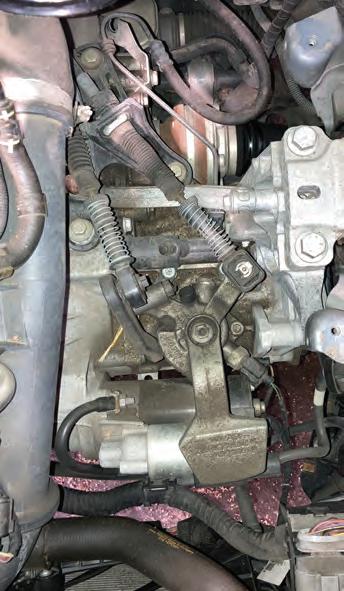

the gear selector arm/weight, which allows the gearbox mounting brace to be removed.
Disconnect the reverse light switch multiplug, followed by the wiring for the starter motor, then remove the two slave cylinder retaining bolts and ease the slave cylinder out of the bellhousing. This can now be stowed away from the gearbox without disconnecting the hydraulic system and provides good access to remove the upper bellhousing bolts. Raise the vehicle lift to waist height and remove the N/S/F wheel and wheel arch liner, unbolt the N/S/F inner CV
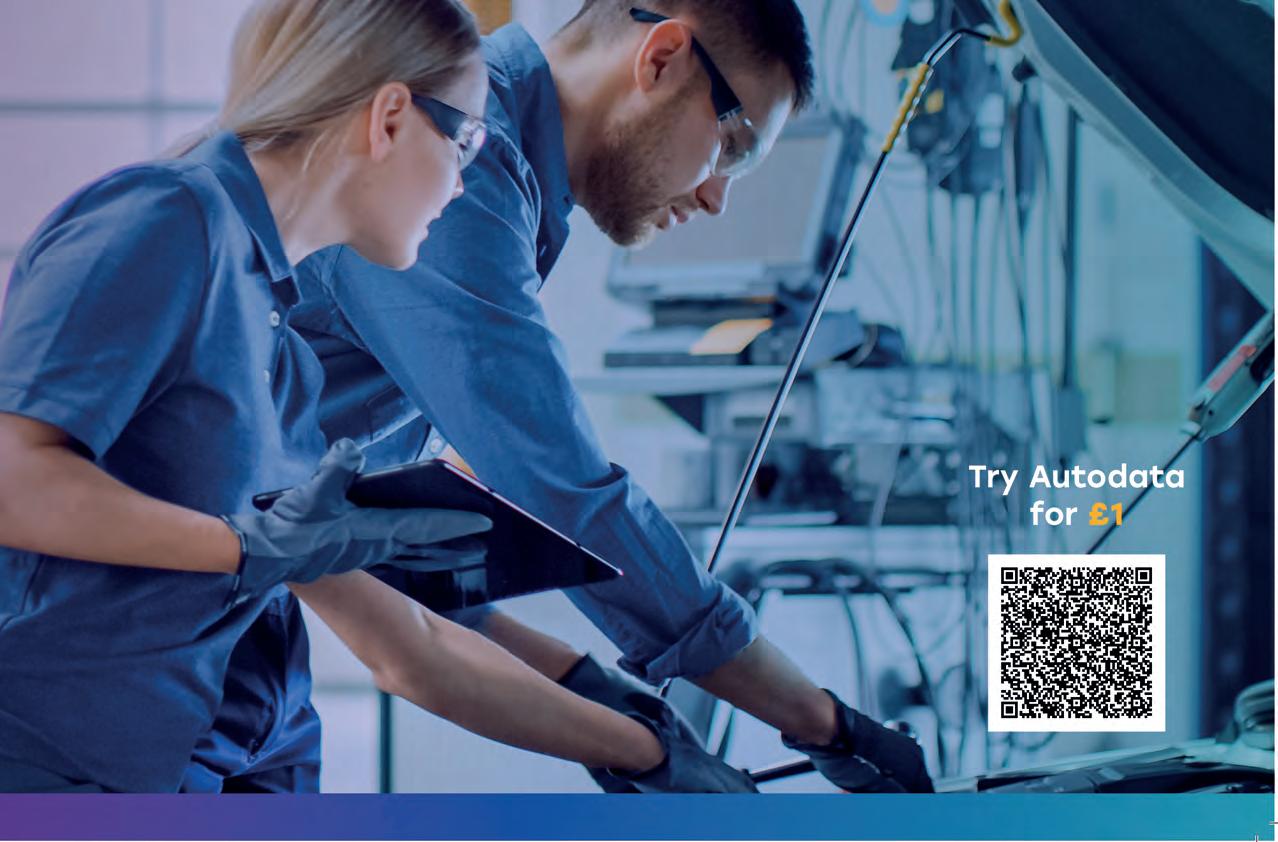

assembly, lower the transmission jack and remove the gearbox from the vehicle.
Clutch replacement
With the gearbox disconnected, remove the six clutch pressure plate bolts and the clutch assembly. At this point the clutch fault in this repair was evident, as the clutch plate lining had reached the end of its service life as it had worn down to the metal retaining rivets. As this vehicle is fitted with a solid flywheel, remove the clutch dust using clutch and brake dust cleaner, remove the glaze from the flywheel surface using an emory cloth and clean again


release bearing and fork assembly, then check the guide tube and pivot points for wear. In this instance, we replaced the guide tube, pivot point and release arm, as wear was evident (Fig.5). Clean the bellhousing area removing the old clutch dust using a clutch and brake dust cleaner, then apply a light smear of high melting point grease to the splines on the input shaft and mount the new clutch plate onto the shaft, which will confirm the clutch plate is correct, as well as evenly distributing the grease. Remove the clutch plate and wipe away any excess grease, then, using a clutch alignment tool,

torque required bolts to the manufacturer’s specification and these values are available on Schaeffler’s REPXPERT workshop portal.
After the battery lead has been reconnected, reset all electrical consumers and carry out a full road test to ensure that the repair has been successfully completed.
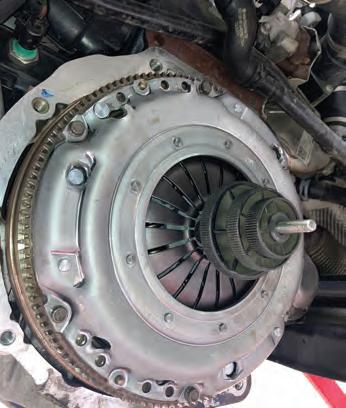
READ ME TO COLLECT YOUR CPD POINT CPDZONE 16 DECEMBER 2023 PMM WANT TO KNOW MORE? FOR MORE INFORMATION WWW.RDR.LINK/ABD001

TROUBLESHOOTER
Improving your diagnostics
Ben Johnson investigates how using an oscilloscope along with verified data can help you improve your diagnostic efficiency.
This month, I want to emphasise the significance of building your personal library of information and underscore why it holds such a vital role in our work. Let’s delve into the world of BMW, a company that continually provides us with an abundance of diagnostic challenges, keeping us on our toes. While this constant stream of issues keeps us engaged, what's less than ideal is BMW’s tendency to withhold crucial data –practically none at all. Even in the realm of technical training, based on my experiences working with both BMW dealerships and specialists, there’s a conspicuous lack of information regarding what things should look like when they go awry.
Finding the problem
This week brought another typical job into my garage, an F15 X5 Hybrid. But unlike the usual suspects – BDC failures and gearbox meltdowns – this one presented a good old timing chain problem. Timing chain issues are no stranger to us, as they are a common occurrence in many workshops. However, what set this one apart was my decision to employ a scope to analyse it, capturing the waveform for my personal library.
Admittedly, my library is a bit scattered and disorganised, with data strewn all over the shop, but one thing is certain – I have an abundance of invaluable data and this is the point that I am making – all of us should maintain such a collection because, as you'll discover as you continue reading, knowledge not only saves a significant amount of time but can also pave the way for those coveted monthly bonuses we all strive for.
The engine sounded surprisingly smooth, but the ominous glow of the MIL (malfunction indicator light) in the corner

“Knowledge not only saves a significant amount of time but can also pave the way for those coveted monthly bonuses we all strive for.”
Ben Johnson, diagnostics expert.
was a silent testament that all was not right (Fig.1). The customer had thoughtfully provided us with the fault codes, most likely retrieved from a dodgy looking USB dongle that I had noticed plugged into the diagnostic socket during my attempt to connect the new Thinklink – the wireless diagnostic link from the Thinktool we recently acquired.
With the Thinktool at the helm, it swiftly retrieved the fault codes from the DME. Among them, the exhaust camshaft synchronisation with the crankshaft fault code appeared, immediately sparking my suspicion of a stretched timing chain. Yet, a dilemma arose. While I’ve scoped chains for potential stretching over many years, BMW makes it more complex due to the unique nature of each engine. Take the S series V8, for example – not a walk in the park to interpret, I assure you. The X5 I was dealing with featured the N20 engine with twin Vanos and a centrallymounted Valvetronic servo motor, easier to interpret the valve timing than a V8 however my problem was clear – I had no reference scope pattern to compare it to. A quick online search led me to an invaluable resource in Kyiv, Ukraine – Rotkee. Although they
READ ME TO COLLECT YOUR CPD POINT CPDZONE
18 DECEMBER 2023 PMM
Dreaded MIL illuminated

primarily deal in car diagnostic tools, their waveform repository proved to be a treasure trove. This is where I found a reference image of an N20 engine with a pristine timing chain – one free of defects such as stretching or vanos sprocket anomalies. It’s moments like these that highlight the paramount importance of having a well-organised reference library, wouldn't you agree?
The fault code 130F20 immediately caught my attention (Fig.2), as I’ve encountered this issue countless times in N20 powerplants, and it has consistently pointed to a stretched timing chain. However, in the spirit of thoroughness, I saw an opportunity to put the Thinktool scope through its paces and create a record for my personal library. The code 120308 could be as a result of the exhaust camshaft timing fault. I may be able to confirm that link in a future follow up article. This article primarily will focus on the timing issue initially.

Connecting the Thinkscope is a breeze –simply attach the USB to the Thinktool and insert it into the scope box, connect your BNC cables, and you’re ready to go. Backpinning wasn’t an option due to the DME’s small connectors (NANO MQS) and delicate wiring, so I opted to expose a small section of outer sheathing and attach crocodile clip probes for a secure and reliable connection. After configuring channel one for the crankshaft signal and channels 2 and 3 for both camshafts, all that remained was to press “auto”, and the Thinkscope handled the waveform – a substantial timesaver compared to the antiquated AVL Di-Test, now relegated to the scrap heap.
The scope revealed a vivid image (Fig.3), making it evident that the exhaust camshaft was out of alignment with respect to TDC (indicated by the yellow trace) on the crankshaft. However, here’s the catch: in
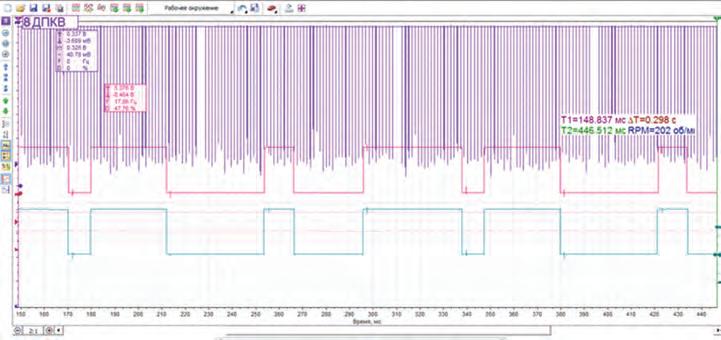
certain BMW engines, the valve overlap you see in the magenta and blue traces can appear deceptively similar, even in engines without any faults. The N20, on the other hand, offers a more straightforward and distinct pattern. It comprises exhaust and intake cams with no overlap, but once Vanos and Valvetronic come into play, things can change. Perhaps, on a future occasion, I should create a waveform to record the independent advancement and retardation of the camshafts. In its current state, the engine operates under no load, and the variable valve timing should be in a neutral position –or at least, it should be. To gain a better perspective, take a look at another waveform I found on Rotkee’s website (Fig.4).
Tackling the problem
To address this issue, my first step was to tackle the laborious task of removing the cam cover, a challenge exacerbated by the imposing presence of the X5 wrapped around me. With the cam cover out of the way, I could then directly access the exhaust camshaft to inspect why it was not synchronised. Employing a spanner, I turned the camshaft and scrutinised the Vanos sprocket – to my satisfaction, there was no play or slackness, effectively ruling out any mechanical problems. However, I strongly recommended replacing this sprocket, along with the intake sprocket, as using a new chain with old sprockets is a practice best avoided. Furthermore, there were no fault codes reported for the Vanos solenoids, which, on the N20, have established themselves as dependable, unlike the earlier N43’s long finger-type solenoids.
PMM DECEMBER 2023 19
130F20. A sign that the timing may be off.
The magenta trace shows the exhaust camshaft in relation to TDC at the crankshaft (yellow trace).
Both camshafts are in a similar position to the case study intake camshaft which was correct. Both camshafts are synchronised to the crankshaft correctly. Image courtesy of Rotkee/VWAUDI.




Upon closer inspection, the intake camshaft appeared to be in good condition, visibly aligned at the 12 o’clock position (Fig.5). However, the exhaust camshaft, as indicated by the earlier scope trace, was noticeably out of sync, resembling a position closer to 7 minutes past the hour, if that description makes sense (Fig.6).
For many years, BMW engines have embraced keyless design, lacking dowels or woodruff keys, even on the crankshaft. This feature elevates the importance of precise timing. Once the Vanos sprockets are removed and then replaced, and the timing chain is reassembled, the use of camshaft phase wheel locking tools becomes indispensable to ensure that cam timing is impeccably aligned. The phase wheels cannot be aligned without a specialised tool. Additionally, this tool proves handy as a visual guide to gauge the extent of timing misalignment on the exhaust camshaft before repair.
You may have noticed that I refrained from locking the crankshaft during this repair process. I found no need to invest additional time in this step, given the challenging location of the locking pin orifice, which would have consumed an unreasonable amount of time to remove the blanking pin and secure the engine. The compelling evidence lay in the absence of intake camshaft/crankshaft correlation fault codes, indicating that the crank timing was essentially correct and the intake camshaft timing also correct. In a situation where time was of the essence – as the customer surprisingly desired the car’s swift return – this decision was pivotal (Fig.7).
The replacement of the timing gear is scheduled for completion next week. However, on that very day, I had to ensure the car was ready to go back to the customer. Such is the relentless pace and pressure of a fault finder’s daily life.
I hold a strong conviction that a new chain and a set of Vanos adjusters (sprockets) will effectively resolve this problem. This case study serves as a reminder of the pivotal role that your own reference library plays. This job, from reading fault codes to setting up the scope, researching online to interpret values, and the final step of physically removing the cam cover for visual confirmation, took approximately three hours. It's essential to remember that when faced with a potential stretched chain, a swift and precise diagnosis can save a significant amount of time without needing to loosen a single bolt or getting one's hands excessively dirty. With the right library of data and a strategic approach, we can all work more intelligently, ultimately saving time for both ourselves and the customer while contributing to reaching that monthly bonus sooner. Until next time, keep learning and keep improving every day. I hope that this article has inspired you to begin building your very own reference library because it will be the best decision that you make as you continue down the path of self development.
20 DECEMBER 2023 PMM
READ ME TO COLLECT YOUR CPD POINT CPDZONE WANT TO KNOW MORE? FOR MORE INFORMATION WWW.RDR.LINK/ABD002
Not surprisingly, the exhaust cam phase wheel was a mile out.
Intake camshaft locked in place correctly.
Exhaust camshaft not at the 12 o’clock position as seen both visually and from the previous scope trace. Intake cam timed correctly. Note the QR code at the 12 o’clock position.


CHARGING WIRELESS POWER TRANSFER E V
Wireless power transfer (WPT) is a system for wirelessly charging the batteries in electric vehicles. There are two main methods:
Stationary WPT
Dynamic WPT
With stationary charging, the electric energy is transferred to a parked vehicle. In dynamic wireless charging systems, the energy is transferred via a special driving lane equipped with a primary coil system at a high power level to a secondary coil of a moving vehicle. Because the range of most EVs is now good, the need for dynamic charging has reduced. I will, therefore, concentrate on static or stationary WPT.
To wirelessly charge, a suitably equipped electric vehicle simply parks over an induction pad and
charging commences automatically. Just like with wired connections, the rate of charge is set from within the vehicle. There are no visible wires or connections. A primary charging pad is buried or set on the ground (on a drive or in a garage for example) and a secondary pad is integrated onto the vehicle.
The power supply (Fig.1) takes a mains voltage input and produces high-frequency current (>20 kHz). Its output current is controlled and applied to the primary pad.
Power is transferred from the primary pad to the secondary pad using transformer action. The onboard charger takes power from the receiver pad and provides a controlled output to the battery. The controller is required to provide an output that

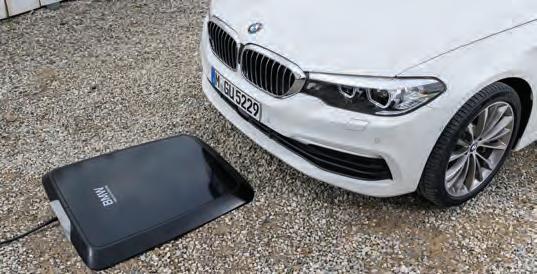
remains independent of the load and the separation between pads.
BMW has developed a wireless charging system. As soon as the vehicle has been parked in the correct position above the inductive charging station (Fig.2), a simple push of the stop/start button, starts the charging process. Once the battery is fully charged, the system switches off automatically just as if it was plugged in.
The system helps the driver to manoeuvre the car into the correct parking position with the help of a Wi-Fi connection between the charging station and vehicle. An overhead view of the car and its surroundings is displayed in the centre control display. Coloured lines help guide the driver into the correct spot. A graphic icon shows when the




correct parking position for inductive charging has been reached. This can deviate from the optimum position by up to 7 cm longitudinally and up to 14 cm laterally.
The contactless transfer of energy between the GroundPad and CarPad is conducted over a vertical distance of around 7.5 cm. The GroundPad generates a magnetic field. This induces a voltage in the CarPad, which then causes a current flow to the onboard charger (just as if the car was plugged in).
WPT is designed for slow charging so is ideal for home chargers where, for example, you simply park the vehicle as normal and charging automatically takes place overnight.










Sponsored by FOR MORE INFORMATION GO TO WWW.RDR.LINK/ ABD003
READ ME TO COLLECT YOUR CPD POINT
FIG.1 Inductive wireless charging: 1) power supply 2) primary pad 3) wireless electricity and data transfer 4) secondary pad 5) onboard charger and controller 6) battery



PMM THE PODCAST

WHAT DO CHANGING A BATTERY, CHANGING A BABY (JUST THE NAPPY) AND CHANGING YOUR MORNING RADIO STATION ALL HAVE IN COMMON?
THEY OFFER THE PERFECT OPPORTUNITY TO LISTEN TO THE PROFESSIONAL MOTOR MECHANIC PODCAST WITH KIERAN NEE.
HEAR ADVICE ON PRICING JOBS, MANAGING PARTS SUPPLY, ELECTRIFICATION, RECRUITMENT AND MUCH MORE.







Listen on Google Podcasts Listen on Apple Podcasts Listen on Amazon Podcasts Listen on Spotify Podcasts LISTEN NOW ON YOUR PODCAST PLATFORM OF CHOICE
KNOW YOUR PARTS
Positive Crankcase Ventilation
febi takes a detailed look at crankcase emissions, as well as outlining some common cases where the emissions ventilation system fails.
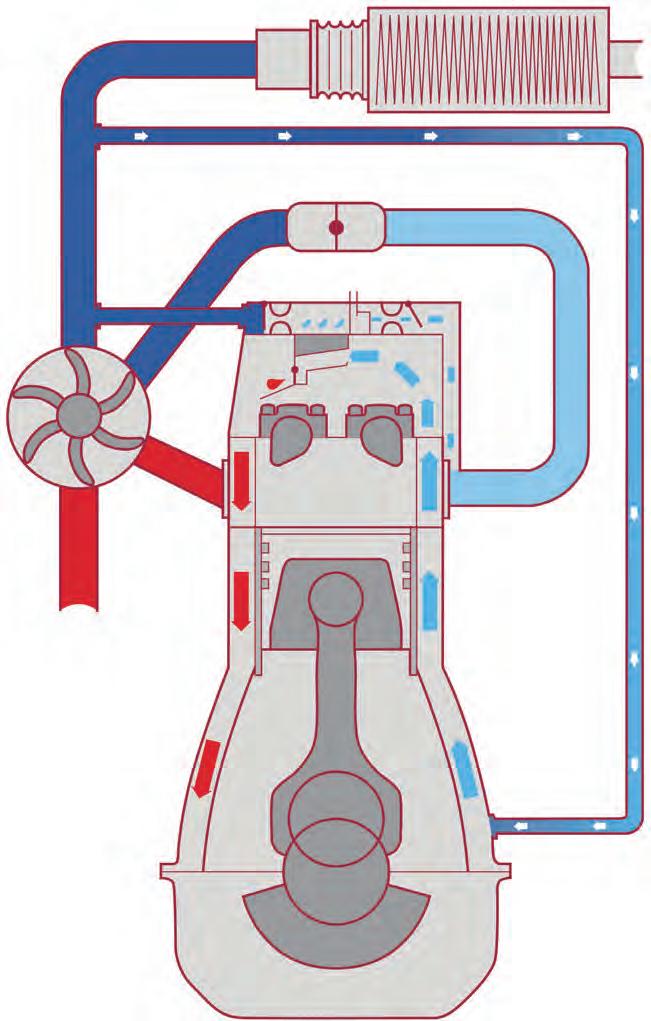
Crankcase emissions are produced as a result of the combustion process of the internal combustion engine. These are a by-product of this process, with exhaust gases escaping from around the piston rings and into the crankcase. The overall volume of these gases varies depending on cylinder pressure, piston ring pressure and component wear. The elements found in these blow-by gases include wear particles, oil, fuel, gas and air. The specific composition of the elements varies depending on the fuel, engine configuration, engine speed and load, and maintenance history of the engine.
How do they work?
These blow-by gases are typically made up of hydrocarbons (HC), carbon monoxide (CO), carbon dioxide (CO2), nitrogen oxides (NOx), water vapour and traces of sulphates and aldehydes. The crankcase hydrocarbon emissions are normally about 3 per cent of the total exhaust emissions tested at the midlife of the engine. However, due to piston ring tolerances, crankcase hydrocarbon emissions can increase to 20 per cent of the total hydrocarbon emissions.
If not controlled, these gases can contaminate the lubricating oil, resulting in sludge. The crankcase can be pressurised –causing oil seals to fail – which, in turn, can lead to oil leaks, as well as having an impact on the starting and the smooth running of the engine and exhaust emissions.
Positive crankcase ventilation is a system that was developed to regulate the internal engine pressure and remove harmful vapours from the internal combustion engine. This prevents these vapours from being expelled into the atmosphere.
24 DECEMBER 2023 PMM READ ME TO COLLECT YOUR CPD POINT CPDZONE
The PCV system does this by using a manifold vacuum to draw vapours from the crankcase into the intake system. The separated droplets of oil flow back to the oil sump and the cleaned blow-by gases are recirculated into the intake area. They are then carried with the fuel/air mixture into the combustion chambers, where they are burned. Every car has some form of crankcase ventilation system, which can consist of several basic parts including hoses and connectors, an oil separator and a ventilation valve. These components can be separate or built into the engine.
The most typical defects of a crankcase ventilation system are a rupturing of the rubber valve membrane and blocked or split hoses or ducts. This leads to high oil consumption, burning oil, loss of power, misfiring, and high carbon deposits. Early signs of a failing PCV system include whistling noises from the intake, blueish smoke in the exhaust, high oil consumption, and thick white or yellow residue under the oil cap. However, many of these symptoms can go unnoticed or be misdiagnosed –mistaken for other issues or components. Here are a few common crankcase ventilation system examples:


Land Rover Freelander TD4 and Range Rover TD6
The engine oil is leaking – usually from the dipstick tube, because the dipstick has been pushed out under crankcase pressure. Other symptoms include lack of engine power (the engine will not increase in speed), black or blue exhaust smoke and excessive oil consumption.
These are caused by a blocked crankcase breather filter – this filter is located in the depression control valve assembly, which is fitted to the camshaft cover. Replace the blocked filter and the complete breather valve assembly, clean any excess oil leaks, and test.
Various Volkswagen, Audi, SEAT and Skoda models, fitted with the 1.8 or 2.0 FSi/ TFSi engine The engine crankcase is maintained in a constant vacuum while the engine is running. The engine is equipped with a crankcase breather valve installed on the rocker cover, directly connected to the intake manifold.
The crankcase blow-by gases are separated into two stages. Firstly, the primary oil separator in the oil filter housing removes the majority of engine oil from the gases. Secondly, the separator on the rocker cover removes the remaining engine oil vapour from the gases.
The turbocharged variants have a more sophisticated pressure control system. A twostage pressure control valve is located on the rocker cover. When the intake manifold vacuum is present, blow-by gas flows into the intake manifold. When turbo-boost pressure is present, the one-way valve in the breather valve assembly closes and blow-by gases flow into the valve cover.
Over time, contamination causes reduced air flow and the rubber membrane can split in the oil separator. Additionally, the sealing joints between the breather hoses become dry and do not seal.
The faulty oil separator or hoses cause the following symptoms: engine idle speed to fluctuate and stall, whistling noises from the engine at idle speed and increased oil consumption.
Various BMW models, fitted with the N20 engine
In earlier BMW engines, the crankcase ventilation system was designed to be outside the engine. In the N20 engine – and many others – the crankcase ventilation valve is built into the top of the rocker cover.
The blow-by gases pass through the opening in the intake side, with spring tab separators in the rocker cover. The oil in the blow-by gases is separated by the spring tab separators and flows along the walls, down through a non-return valve and back into the cylinder head. The blow-by gas cleaned by the oil now passes into the air intake system.
The most typical defect of this crankcase ventilation system is a rupture of the rubber valve membrane. The rocker cover, which is continuously exposed to heat cycles and vibration, can crack and leak. The oil separator galleries can clog with oil particles and residue.
PMM DECEMBER 2023 25 WANT TO KNOW MORE? FOR MORE INFORMATION WWW.RDR.LINK/ABD004
vent
Rocker Cover with
valve Breather Valve for crankcase


DIAGNOSTIC GUIDE
Using Bosch’s ESI[tronic] 2.0software: a monthly guide
A few years ago, PMM ran a guide from Bosch on its KTS diagnostics software, ESI[tronic] 2.0. We thought it would be a good idea to revisit the guide with Bosch and find out what’s changed. In this fourth instalment, we are looking at how to identify known fixes with experience-based repair.
Last time we delved into the time saving potential of the ‘service tasks’ tool. By putting all the tasks your workshop team need to complete right at their fingertips – in seconds – ‘service tasks’ gives your engineers a head-start on the work at hand. While the experience based repair (EBR) –known fixes feature helps them take efficiency to the next level.
With the online knowledge exchange growing by the day, many workshops are turning to Google for their repair instructions. While the internet is a huge data source, many results are unvetted and unverified. Leaving a lot of time-consuming legwork for your team, even if the initial search goes smoothly.
By aggregating knowledge from across a worldwide diagnostic community of 75,000 experts, EBR – known fixes aims to cut out potential hours wasted searching the web. From the technical hotline and internet forums to trending Google searches – the EBR-finder utilises an innovative algorithm to identify common problems from across a wide variety of sources and alert our experienced ESI[tronic] SIS authors of any emerging challenges being experienced in
the field. The team then check the entries forplausibility and validate the data to create Bosch-quality content to guide you through the fix.
Found under the known fixes tab, EBR –known fixes allows you to find the right solution in seconds. Once registered, you can freely type any text into our search agent to find common fixes by fault code, symptom, component or keyword.
Ranked by likes
Find the most popular fixes, fast. Thanks to the feedback feature, it is easy for technicians on the ground to rate a fix – helping you to easily see the industry’s best-ranked solutions (Fig.1). It also enables you to have your say on how useful you found a particular fix.
You can quickly and easily search the database of fixes by keyword. Just like you would if you were relying on traditional search engines. The biggest difference? Every result is Bosch approved (Fig.2).
Every Bosch approved fix follows the same format:
Complaint
A brief summary of the issue.
Your pathdiagto success!
General conditions
A list of any relevant symptoms.
Possible causes
The most common reasons why this fault may occur.
Remedy
The known fix for these challenges.
Quick and reliable repairs are the foundation for excellent results and satisfied customers. With more than 1,500,000 real life use cases – and growing – it’s never been easier to find the right solution for your problem.
As on online service that is updated automatically, EBR – known fixes aims to always bring you the very latest repairs and adaptations from its ever-growing database.
Next month we will discover how the Bosch ESI[tronic]’s service information system – or SIS for short – can guide you from symptom detection and associated trouble code to root cause and rectification.
26 DECEMBER 2023 PMM READ ME TO COLLECT YOUR CPD POINT CPDZONE
WANT TO KNOW MORE? FOR MORE INFORMATION WWW.RDR.LINK/ABD005
What was causing noise on the front wheels of the 2017Audi A5 Sportback?
Autodata helps one garage get to the bottom of why their customer’s Audi A5 was making a metallic noise from the front wheels when manoeuvring and parking.
The problem
“A customer's 2017 Audi A5 Sportback is in for a service and the owner has reported a metallic noise from the front wheels whilst manoeuvring or parking. We have heard the metallic noise and we suspected it was originating from the front brake pads due to them being very low. After replacing the front brake pads and road testing the car the metallic

noise is still apparent. Are you aware of other Audi owners who may have reported this type of metallic noise before?”
What does Autodata recommend?
Yes, this fault has been reported to us by A5 Sportback owners with late model year vehicles. The metallic noise is due to movement between the front wheel bearing housing and the front hub carrier. Remove the front wheel bearing housing from the hub carrier, but do not remove the wheel hub from the front wheel bearing. Thoroughly clean all corrosion

from the front wheel bearing housing and apply a light coating of Optimolpaste, available from Audi parts department, to the mating surfaces of the front wheel bearing housing and hub carrier. Refit the front wheel bearing housing to the hub carrier. Repeat the procedure for the opposite side and road test the vehicle to ensure the noise has been eliminated.

READ ME TO COLLECT YOUR CPD POINT CPDZONE WANT TO KNOW MORE? FOR MORE INFORMATION WWW.RDR.LINK/ABD006 Find more quick fixes from Autodata on the PMM website!
BEST PRACTICE
Working on suspension mounting kits
Suspension specialist KYB offers its advice on diagnosing and replacing suspension mounting kits.
Just like a shock absorber, a suspension mounting kit is pushed and pulled 1,500 times per mile –over the course of 50,000 miles that means this small but important component has moved up to 75 million times, deteriorating the rubber components in the mounting kit.
Worn mountings have an adverse effect on ride control and safety. Mount wear depends on the type of travel, however a good guideline is that if the struts are worn out, the mounts will probably be worn out too. Therefore, suspension mounting kits should be replaced every time the struts are replaced.
Mounting kits provide a rubber cushion between the chassis and suspension, helping to reduce stress on the suspension by absorbing vibration. There is also a bearing in front mounting kits which allows the steering wheel to turn the suspension column and the wheels. It returns the steering wheel smoothly back to its natural straight position if released. Suspension mounting kits can affect the angle of how the shock absorber sits – if the rubber is worn, it can cause extra stress upon it and its surrounding components.
How to diagnose worn mounting kits
Test driving vehicles is a key part of diagnosing suspension issues and helps to explain the issues to the motorist. Find a short circuit that includes the following:
Bumpy road surface/speed bumps (feel for ride harshness)
Listen for noises, feel for steering wheel vibration and any irregularities with the steering
Turn the steering wheel and release your hands – does it return to its natural straight position?

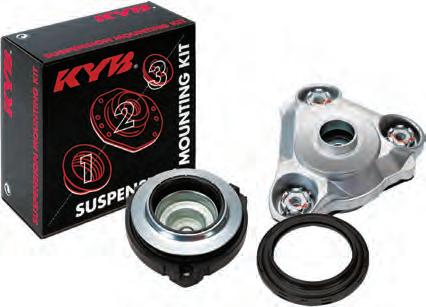
Seized bearing
Fixing points for the upper suspension mounting kit and the shock absorber to the vehicle.
Rubber element used to absorb vibrations transmitted from the chssis to the vehicle.
The bearing is often placed in a rubber cushion reducing friction and ensuring optimal movement of the shock absorber column while turning wheels.
Construction markings indicate the correct mounting position of the upper mounting.
Pick a route by your workshop that is quiet, and one you can use repeatedly
Aim for a 3-minute, 1 mile long route that includes a speed bump, a place where you can brake and accelerate quickly, and swerve safely. Your speed will not need to be over 30mph
When you return to the workshop, eliminate any other factors such as any excessive movement in the other suspension components such as the ball joints and bushes.
Broken/cracked metal – rubber joint
This could have been caused by aggressive driving or road conditions such as potholes and uneven surfaces. It can result in excessive vibrations transferred to the vehicle’s steering system and driver, decreasing comfort, increasing fatigue; changed damping parameters of the suspension; accelerated wear of the suspension and co-operating components.
This could have been caused by incorrect installation if the full weight of the vehicle wasn’t applied when tightening the nuts to the required torque. It can result in excessive vibrations transferred to the vehicle’s steering system and driver, increased force will be required to move the steering wheel, the steering wheel will not return to a straight position once the steering wheel is released, and there will be noise coming from the suspension.
Deformation of top support bearing
This could have been caused by excessive axle load, or aggressive driving or road conditions such as potholes and uneven surfaces. It can result in excessive vibrations transferred to the steering system, changed damping parameters of the suspension, and noise.
WANT TO KNOW MORE? FOR MORE INFORMATION
WWW.RDR.LINK/ABD007
REDEEM YOUR CPD CREDIT

Congratulations, you have reached the end of the CPD Zone!To access your CPD credit from The CPD Group, scan the QR Code below or
WWW.RDR.LINK/ABD008
28 DECEMBER 2023 PMM READ ME TO COLLECT YOUR CPD POINT CPDZONE
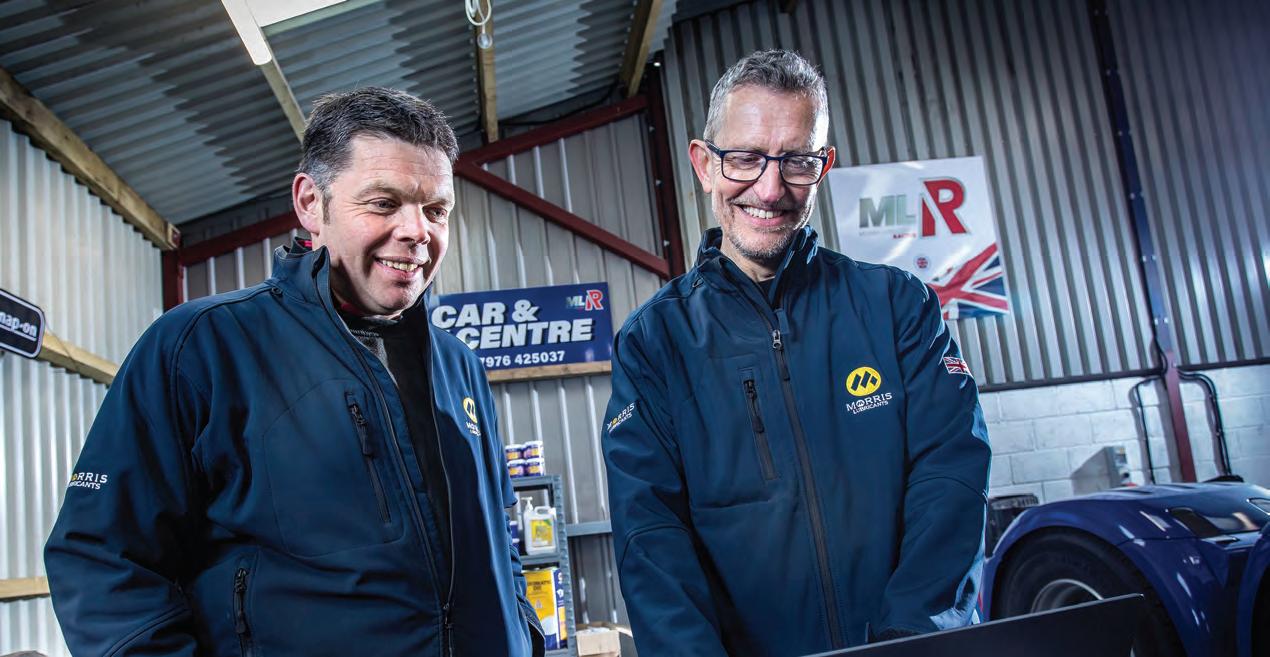

Yourguideto ANTIFREEZE COOLANT



Operating at high temperatures…
The best cooling medium is water. However, when the engine reaches running temperature it will exceed the boiling point of water, 100˚C. If the water boils away, catastrophic damage can occur in the engine. To combat this, antifreeze coolants feature the addition of monoethylene glycol, which elevates the solution’s boiling point to around 108˚C.
…and low temperatures
If the engine has been at rest and the ambient temperature falls below 0˚C, water freezes, and the ice formed expands. This is a big issue in the engine cooling system as there is nowhere for the expansion to go. As the water freezes, high internal pressures are generated that can crack heads, cause splits in cylinder liners, make hoses leak, fracture radiators and break water pumps. By incorporating monoethylene glycol to the water it reduces the freezing point, potentially driving it down to -35˚C.
Inhibitors
Another important function of an antifreeze coolant is to prevent any metallic components from rusting or corroding, such as the engine block, water pumps or gaskets. It is therefore essential that the antifreeze coolant uses the
chemistry is referred to as either inorganic or organic acid technology.
Inorganic chemistry is extremely active and will seek out all materials in the cooling system, whether susceptible to rusting or corrosion or not. This constant level of activity results in it becoming depleted after around two years. At this point it should be drained and changed.
Organic acid technology only targets materials where rusting or corrosion is starting to take place. This chemistry is selective and does not become depleted as quickly and will work for up to five years. Some manufacturers may require a combination of these technologies and ‘hybrid’ antifreezes are available for specific engine designs.
And there’s more!
Additional chemistry may also be added to the formulation of antifreeze coolants such as antioxidants to stop corrosive acid formation as well as additional compounds to prevent hard water deposits and extra pH buffering agents to maintain an optimum pH level (around 8). The formation of foam can also inhibit the properties of the antifreeze coolant, therefore an antifoaming agent may be added to the formulation to prevent foam developing within the cooling system.

how the antifreeze coolant performs in terms of engine protection.
Choosing the correct antifreeze coolant
As engine designs become more complex and engines are manufactured from different metals and composite materials, the correct antifreeze coolant must be used. If not, the antifreeze coolant will damage the engine and reduce itsefficiency. When choosing the correct antifreeze coolant, you need to make sure it meets the specifications set by the engine manufacturer.
Antifreeze coolants perform in the engine all year round and do not just cover the winter months. Selecting the correct antifreeze coolant is vital and choosing a product based on colour should be avoided. Best practice is to select the antifreeze coolant based on the engine manufacturer’s specification. If there is any doubt as to which antifreeze coolant is required, check with the engine manufacturer, seek independent technical advice, or use online tools such as www.whatoildoineed.com
PMM DECEMBER 2023 29 SPECIAL REPORT
WANT TO KNOW MORE? FOR MORE INFORMATION WWW.RDR.LINK/ABD008
Straightset outlines how you can effectively use wheel clamping systems during wheel alignment.
Working for the CLAMPDOWN
In the garage, precision is paramount. When it comes to wheel alignment, the importance of precise measurements cannot be overstated. Enter the unsung heroes of this crucial operation: wheel clamps. These unassuming, yet essential, tools come in various shapes and sizes, each offering unique advantages tailored to different needs.
The choice of wheel-clamping device does play an important part of any wheel aligner and alignment process, especially with the suspension set ups on modern vehicles where accuracy is dependent on fitting the clamps correctly, performing the all-important run-out compensation as well as using a fully calibrated machine and accurately level lift platform.
damage to alloy wheels and is still a popular choice amongst wheel alignment professionals today. This offers an alternative to a clamp system, and can cater to tyres from 12 inches to 24 inches.

Self-centring clamps

Initially there was only either a 3-point or 4-point claw type clamp available, though as nearly all vehicles had steel rims this didn’t present any problems with potential damage that can occur if the fingers of the claw grips are themselves damaged or broken. With most of today’s vehicles having alloy rims as standard, solutions to the potential problem of rim damage, as well as speeding up the wheel alignment process, have been available for some years now with the introduction of different clamping styles. Here are some of the systems available today:
Hang on system
The hang on system, with no clamping and the use of rim buttons, made popular by Supertracker, eliminated any potential
With advancements in product design, the self-centring clamp system, which has nylon feet that sit up against the rim with claws that wrap around to grip the tyre, are a very successful design which is still used today and available as an update to the Supertracker CCD system. These clamps automatically centre themselves on the wheel when applied, eliminating the risk of human error. This precision not only ensures more accurate alignments but also enhances the safety and performance of the vehicle and offer a solution to performing wheel alignment on lowered vehicles. With 3-point and 4-point clamps available, these are still going strong today and with suitable extensions that can be used on rims up to 28 inches in diameter.

Specialist clamps
Some specialist vehicles and vehicle manufacturers require specialised attention and that includes for wheel alignment. As a leading wheel alignment manufacturer, Beissbarth, began to produce individual clamps for BMW and Mercedes Benz initially, which used pin sets to locate the clamp against the hub with wrap around claws to grip the tyre tread. This type of clamp ignored the rim and measured directly from the hub, allowing for the runout compensation to be skipped but still giving a very accurate measurement.

This spilled out to other marques who wanted a unique, and accurate clamping method, notably Porsche, Tesla, Ferrari, Lamborghini and very soon the JLR range, who have opted for centre mount devices, all machined to very fine tolerances to fit in place of the rim’s centre cap. There are variations of clamp depending on the model.
Magnetic clamps
With the introduction of the Beissbarth ML3D wheel aligner another advancement in wheel clamping was launched: the magnetic
SPECIAL REPORT
30 DECEMBER 2023 PMM
clamp. By using strong magnetic studs they affix to the vehicle’s steel wheel studs. This has proved to be a quick and easy clamp for the technician to use, less cumbersome than most other wheel clamps on the market.
Quick clamps
In today’s fast-paced world, every second counts. Q.Grip clamps are designed with efficiency in mind. Their swift application, courtesy of a lever mechanism, streamlines the alignment process. For busy auto shops, these clamps translate into faster turnaround times, increased customer satisfaction, and higher productivity. The latest product from Beissbarth is the Q.Grip, to complement the Q.Lign wheel aligner range.

These are a patented design and provide the technician with a very quick clamp that wraps around the tyre at three points and with the all-important run-out compensation performed have proved to be as accurate as all other clamping devices. Wheel alignment isn't just about functionality; it's also about aesthetics. Nonmarking clamps come to the rescue by using rubber or soft material pads to prevent damage to wheel finishes. For high-end or custom wheel owners, this means preserving the appearance and value of their investment.
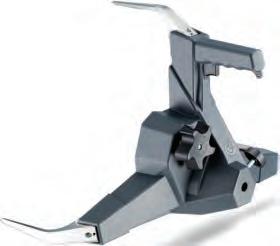
In conclusion, wheel clamps may not be the first thing that comes to mind when thinking about automotive maintenance, but they are integral to achieving precise wheel alignments. Their diversity caters to various vehicles and needs, from quick alignments in a bustling workshop to intricate precision work on specific vehicle manufacturers. By selecting the right clamp for the job, auto technicians can ensure safer, more efficient, and more accurate wheel alignments, ultimately benefiting both customers and their bottom line.

WANT TO KNOW MORE? FOR MORE INFORMATION WWW.RDR.LINK/ABD009

INSIDE INTELLIGENCE

Providing safe, accurate vehicle repairs and getting customers back on the road quickly means starting with the right tools: ALLDATA Repair offers exactly that by providing up-to-date OEM mechanical/body repair information and procedures for 91,950 unique vehicle combinations – more than 95 per cent of all vehicles on the road today. The portal comprises of six million technical drawings and wiring diagrams, including electrical connector views, which are available in five languages.
To show how ALLDATA Repair can be used in the real world, let’s look at a recent case the team has dealt with.
ALLDATA PARTNERS WITH SCHAEFFLER
REPXPERT, a digital platform and community developed by Schaeffler, is dedicated to supporting automotive professionals with product and technical material; therefore, its collaboration with ALLDATA Europe, a provider of genuine OE repair and maintenance information, is a perfect fit.
REPXPERT members in the UK can access this invaluable resource by simply clicking on the ALLDATA Repair banner within the REPXPERT web portal. This will transport them to a new landing page where they can request a two-week free trial. This period will grant them unrestricted access to original repair and collision information for 36 VMs, all of which have licensing agreements with ALLDATA Europe.
2019 MY PEUGEOT 208 1.2I
The team at the ALLDATA Repair Info Centre Service was recently presented with an issue on a 2019 MY Peugeot 208 1.2i. The vehicle owner had been experiencing, what they described, a “dull knocking noise” coming from the front of the vehicle. Bizarrely, though, the motorist would only hear it during warm weather and when the vehicle was at idle. This made the problem difficult to pinpoint and diagnose, making the conversation between technician and customer awkward, potentially.
Solution
Thankfully, the ALLDATA Repair Info Centre Service experts were able to come to the workshop’s rescue. They had been presented with this issue before and managed to get to the bottom of the problem quickly.
The cause of the knocking noise was due to internal damage within the vehicle’s front right-hand engine mounting. To rectify, simply, the technician needed to replace the broken mounting, being careful to use the correct VIN number to ensure the correct, modified engine mounting was supplied.
Once the part arrived, to complete a professional and accurate repair, the technician required a specific torque of 6daNM –information available, of course, on ALLDATA Repair!
Mercifully, this intervention from the ALLDATA Repair Info Centre Service meant the technician was able to conduct the work and hand the keys back to a relieved and happy customer – no more knocking noises heard!
ADVERTORIAL
32 DECEMBER 2023 PMM
SIGN UP FOR A FREE TRIAL AT WWW.RDR.LINK/ABD010





OPTIMISED HANDLING FOR CAMPER VANS
Motorhomes and camper vans have been experiencing a steady upward trend for years and, according to experts, there is no end in sight to the ongoing boom. With the growing number of newly registered motorhomes, the demand for used ones is rising at the same time. However, to ensure that the dream of a holiday on wheels does not turn into a nightmare, buyers should pay particular attention to the suspension as well as the mileage and age of the respective components when purchasing a used model. In any case, a thorough suspension check in the workshop is recommended to owners of motorhomes past their prime. When passengers notice roll and sway or decreasing ride comfort inside the camper, this is often due to worn shock absorbers. Even before, this can be insidious because dangerous loss of control is already imminent, e.g. during sudden evasive manoeuvres, sharp bends or strong crosswinds.
To prevent this from happening, an upgrade with the BILSTEIN B6 Camper or Camper Advanced is advisable. Since the summer of 2022, the suspension specialist from Ennepetal offers these two high-performance shock absorbers developed especially for the challenges of such vehicle categories. They have been developed for campers, panel vans and semi-integrated vehicles based on the Fiat Ducato (from model

year 2006) and the largely identical vehicles from Citroën and Peugeot.
BILSTEIN B6 CAMPER

Motorhomes based on the platform of a transporter usually adopt this vehicle’s unmodified suspension. The new dampers from BILSTEIN should be the number one choice for retrofitting, in particular for the alcove models popular among families with small children. As the alcove is partly protruding over the cabin’s roof, it adversely affects the vehicle’s centre of gravity and critical driving situations can quickly arise. Evasive manoeuvres, response to strong crosswinds, but also sudden breaking manoeuvres can quickly lead to an unstable, critical situation of a vehicle with overcab bed.




This is where the improved OE replacement shock absorber B6 Camper can show its additional safety features, with no registration required. In crosswinds and on bends it convinces with optimum grip, offering a more intense driving experience due to high traction and precise handling. At the same time, campers can look forward to a more comfortable driving experience: The reduction of driving noise through better damping contributes to this just as much as the optimised rolling behaviour on cobblestones and at level crossings.


Advanced goes one step further, featuring the innovative DampMatic® technology. This ensures amplitudeselective shock absorption. With this purely mechanical technology, a control piston reacts to the vibrations transmitted from the road and automatically selects one of two characteristic curves. In the “soft setting”, the damper oil flows through both the main piston and a special DampMatic® bypass. In the “tighter” setting, the latter is closed so that the flow is reduced.
Thanks to the DampMatic®, rolling behaviour improves in terms of comfort because the vehicle effectively has two suspension systems in one. This can be felt for instance on bridge kerbs and on cobblestones. What is more, control over the vehicle is dramatically improved, for instance when cornering or changing lanes.
PMM MARCH 2022 1 ADVERTORIAL
BILSTEINB6 SHOCK ABSORBER SERIES INCREASES SAFETYAND IMPROVES HANDLING
B WWW.FACEBOOK.COM/BILSTEIN.UK D WWW.INSTAGRAM.COM/BILSTEIN_OFFICIAL F WWW.YOUTUBE.COM/BILSTEINDE I CAMPER.BILSTEIN.COM

Why are the tips ofsome GLOW PLUGS grey/blue in colour?
One of the OE parts supplied by Denso are glow plugs, so the firm is in an ideal position to dispel an ongoing myth surrounding the part…
Alongside many other products, Denso is a glow plug manufacturer, supplying them as original equipment parts. It also supplies the independent service and repair sector and as its aftermarket range is produced on the same production lines to the same standards, the firm argues they can be relied on by automotive technicians and motorists alike. There is, nevertheless, a notion among workshops that the colour of a glow plugs’ tip can imply that it is not a genuinely new item.
According to the company, the fact that its aftermarket glow plugs are manufactured on the same production line as its OE range, should be enough to reassure those with any concerns over the providence of its glow plugs. However, to clarify the situation and



provide peace of mind for installers, Denso is explaining why the tips have this colouration.
In common with many highly engineered products, the manufacture of glow plugs is a complex process. This is particularly true for the production of the glow tube, which when installed, can be heated up to temperatures above 800°C within seconds. This component is needed to ensure a quick and reliable start when the engine is cold, and to reduce emissions when it is running.
Live testing
As this heating element is the most critical component of the glow plug and allows it to fulfil its role in the ignition system, its functionality has to be verified during the production process. It is for this reason, that at the end of the production line, the performance of each glow plug is thoroughly tested to ensure that it is working in accordance with the given specification, including its heat-up time and the temperature it needs to reach.
It is this in-line production test, that causes the glow plug’s tip to take on this grey/blue tone. This colouration is due to the oxidation of the metal, which is accelerated by the high temperature it is subject to during the test, but it does no harm to the glow plug,
“This colouration is due to the oxidation of the metal, which is accelerated by the high temperature it is subject to during the test”
nor does it degrade its performance.
Therefore, rather than being something of concern to technicians when opening the box, it should be regarded as a sign of reassurance, because it indicates that the glow plug they are about to fit has been tested and works according to its given specification, and will perform as they’d expect a large OE automotive parts supplier.
Denso’s R&D investment helps it to pioneer increasingly efficient and reliable diesel engines with minimal emissions. Its aftermarket division draws on this expertise, offering a comprehensive, all-makes glow plug programme intended to improve start-up performance with extended post-heating temperatures.
PMM DECEMBER 2023 37
BATTERIES & IGNITION
TO KNOW MORE? FOR MORE INFORMATION WWW.RDR.LINK/ABD011
WANT
Colouring, rather than a cause for concern, in fact offers a reassurance of quality

PMM asked Ken Clark, managing director of Rotronics Battery Management Solutions, to give readers an understanding of the importance of maintaining the 12 V battery in an electric vehicle.
Lookafter the little BATTERY
As with traditional internal combustion engine and hybrid vehicles fitted with a 12 V battery, all electric vehicles have a 12 V “auxiliary” battery. The battery technology used in these vehicles are commonly AGM (absorbed glass mat), EFB (enhanced flooded batteries) and can be traditional (flooded) lead acid batteries, or in some cases lithium (LiFePO4) are used.
What may surprise you is that these batteries play a crucial role in managing the functions of the high voltage pack and still require the same maintenance and care practices as ICE vehicles. Improper care and maintenance can lead to acid stratification and sulphation of the battery, reducing its performance serviceable life, resulting in premature replacement and vehicle non-start, as well as an “unhappy driver” experience.
Potential failures
EVs experience roadside breakdowns due to “flat batteries” and when it comes to industry statistics, battery failure remains the top attributable factor for all vehicle roadside callouts. Recent roadside breakdown statistics show that 43 per cent of all roadside breakdowns are as a direct result of the starter battery and this includes both ICE vehicles and EVs. Despite the reduction in EVs’ maintenance requirements, these vehicles still have the same challenges, pitfalls and opportunities to maintain, support and replace the 12 V battery going forward.
What’s the purpose of the 12 V “auxiliary” battery in EVs, how can it fail and what can you do to minimise these risks?
The first table gives a brief overview of its role:
12 V battery purposeFailure problem Impact
Make the car run
(Auxiliary 12 V battery
No access to high voltageVehicle will not start controls EV pack)
Safety
(Power steering, airbags, No power to critical Vehicle will prevent user braking system, lights, signals andsafety functionsfrom driving much more)
Accessories
(In car entertainment, heated No power to vehicle
In car entertainment does sets, radio, navigation etc)accessoriesnot function
Vehicle access
(Doors, windows and boot)Locks are not electrifiedUser cannot access or exit the vehicle in the normal way
What can you do to maintain 12 V batteries?
■ As with all discharged 12 V batteries, charging is required to restore full power performance and maximise battery lifespan and can be achieved using widely available intelligent chargers: it’s the same straightforward process and no special equipment is required.
■ In contrast, the 12 V EV battery will require a unique diagnostic approach tailored to their application, which will assess available safety power capacity, to power critical vehicle systems.
■ As EVs have no engine to start, traditional
ICE
conductance testing is not a suitable measure of battery condition.
■ The development of Midtronics SafetyPower diagnostics platform will accurately measure the available capacity of a 12 V battery.
■ This cutting-edge technology and approach to 12 V “auxiliary” battery testing will provide a precise decision on a battery’s ability to power the vehicle’s low voltage loads.
The table below highlights the necessary evolution in 12 V battery testing, to ensure safer and correct vehicle functionality.
ICE, start-stop,hybridelectric vehicles
Vehicles needStarting the engineIn-vehicle loads, when Power for all systems “engine off”outside of propulsion
Battery FunctionCranking healthReserve capacity SPC (safety power capacity)
Battery TestingConductance Conductance profilingSPC diagnostics Diagnostics
BATTERIES & IGNITION
38 DECEMBER 2023 PMM
Are you getting EV service ready?
■ As many workshops plan and implement electric vehicle service strategies, the inclusion of necessary qualifications and equipment to the support their future needs become a key requirement.
■ While aftermarket tailored equipment solutions enabling high voltage battery maintenance are in development (enabling module balancing and cell replacement). Deployment of the most accurate diagnostic technology for 12 V batteries in electric vehicles is a positive step towards EV service readiness.
■ Unlike electric vehicle traction packs that are relatively reliable and come with up to 10 years manufacture warranty, the 12 V battery is typically backed by a 2-3 year warranty, and can be a simple “win” for aftermarket workshops aiming to keep their EV customers mobile through maintenance and/or replacement of the 12 V battery when the need arises.

■ Getting your workshop “12 V EV ready” by ensuring you have both the correct means to diagnose and charge 12 V batteries and implementing a proactive testing and charging programme as part of your workshop service plan, will ensure you keep your customers mobile, whilst increasing sales revenues and customer satisfaction.
What’s in it for you?
Ensuring your workshop is “EV service ready” begins with correctly matching the right technology to your service offering and ensuring you have the appropriate means to accurately diagnose and charge 12 V batteries in EVs.
Implementing a proactive testing and charging programme is essential in your workshops service plan, will:
■ Help keeping your ICE and EV customers mobile.
■ Boost customer satisfaction.
■ Identify battery problems, before they appear at roadside.
■ Increase revenues and replacement opportunities through pro-active charging and diagnosis.

TO
MORE? FOR MORE INFORMATION
WANT
KNOW
WWW.RDR.LINK/ABD012
GLOW PLUGS: AWarmerWinter
The winter months are the key selling period for glow plugs and Niterra is working closely with workshops to ensure they do not miss out on any service opportunities for its NGK ignition parts range.
NGK glow plugs provide over 70 per cent coverage of the 17.3 million diesel car parc in the UK, as well as frequent newto-range launches to ensure popular and new models join the coverage. The components are often noted for their fast start, reliability, and ability to perform in tough cold weather conditions, something which is becoming increasingly important for a glow plug to deliver. As an indispensable part of the exhaust and emissions system they are also essential for maintaining optimum emissions and play a role in preventing damage to related components, such as the clogging of the exhaust gas recirculation valve with excess deposits.
Seasonal peak
The winter months become a natural pinchpoint for glow plug demand due to seasonal changes and emissions testing, along with

standard servicing requests. Becca Knight, marketing manager, Niterra UK, said: “We work year-round to provide availability of our highly demanded NGK glow plugs ready for the seasonal peak, to ensure workshops have what they need to maximise their service opportunities this winter. Our Original Equipment quality glow plugs
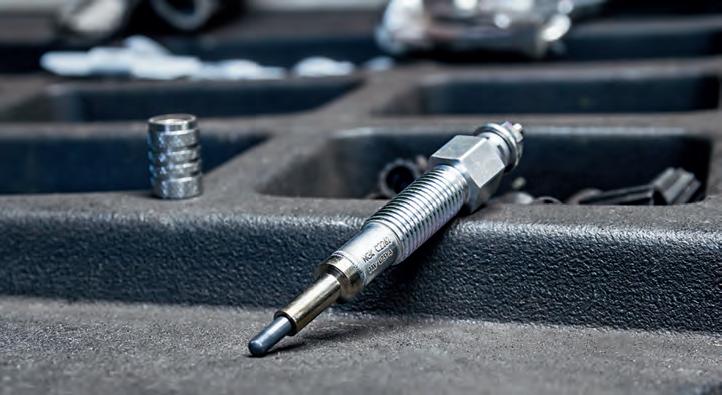

“As an indispensable part of the exhaust and emissions system, glow plugs are also essential for maintaining optimum emissions”
provide workshops with the precision and performance their customers need.”
NGK glow plugs aim to provide workshops with OE quality performance for their aftermarket customers. In some cases, NGK glow plugs will have been the OE fitment of choice for the application, meaning that the workshop can continue to offer the high quality and performance their customers know and expect by stocking NGK for their servicing.
Niterra also supports the recommendation of replacing a full set of glow plugs if one or two are faulty for best results and good customer service. Not replacing the full set, or use of budget alternatives, can be a false economy for the workshop in the form of returning vehicle faults and declining customer satisfaction. Distributors who select NGK glow plugs can extend that best practice and best results to their workshops this winter.
BATTERIES & IGNITION
40 DECEMBER 2023 PMM
TO KNOW MORE? FOR MORE INFORMATION WWW.RDR.LINK/ABD013
WANT
ELECTRIC Avenue
Varta discusses the ongoing relevance of the 12 V battery in EV vehicles.
Did you know, as well as startstop and ICE vehicles, nearly all EVs (BEV, PHEV, FCEV, hybrids) require a 12 V power supply. As cars become more electrified and autonomous, the traditional 12 V lead-acid battery is taking on a new and challenging responsibility as a critical source of power across the evolving range of EVs.
There are an increasing number of electrified vehicles entering the market to support governmental targets of reducing CO2 emissions. Their emergence has intensified low-voltage power demands and is continually redefining the role of the 12 V battery. Enhanced levels of vehicle electrification have driven the 12 V battery to become a safety critical component, particularly if the high voltage battery fails.
An electric car’s high-voltage Li-Ion battery powers the drivetrain and the propulsion system, however not the whole vehicle and not all of its electrical power devices.
The internal electrical 12 V power system with its comfort and critical safety features, is powered by a 12 V battery. It works as a secondary power source for the vehicle’s electrical system and ensures that the car maintains its functionality while driving but also whilst parked and the high-voltage battery is disconnected from the drive train.
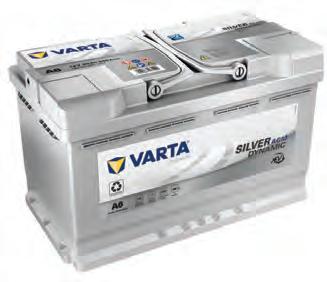

it comes to batteries. However, it is not as inherently robust as other battery technologies and requires continuous monitoring by the battery management system. Overall, it is a very sophisticated technology.
Varta’s absorbent glass mat batteries have proven their reliability for many years. It is their sturdy construction, behaviour and inherent safety that makes them the perfect companion in supporting the 12 V electrical system of EVs.
Comfort and safety features like lane assist, power steering and the brake booster are handled by onboard smart systems which also draw power from the 12 V system. The same goes for most of the car's monitoring functions, it is therefore essential that a reliable 12 V power supply is in good working order.
Traditional technology
Why is lead-acid technology still being used in a modern electric vehicle?
Lithium-ion technology is often considered the successor of lead-acid technology when
Lead-acid batteries, on the other hand, are known to be both reliable and affordable. Their wide operational temperature window intrinsically enhances the operational robustness of the entire system. The safety record of lead-acid batteries makes them invaluable for Europe’s future low-emission mobility sector, plus lifecycle analysis of a vehicle’s environmental impact show that lead-acid has a lower impact compared to other technologies.
“It is safe to say that the unique benefits of lead-acid technology will be important to meet growing consumer expectations for safety, comfort, and connectivity,” says Dr. Christian Rosenkranz, from Clarios, the parent company of the Varta brand.
What makes Varta’s AGM batteries many OEMs’ choice for EVs?
Every major car manufacturer is entering the electric vehicle market with battery electric or hybrid electric vehicles. As the world’s leading battery manufacturer, Clarios is the number one supplier to all renowned original equipment manufacturers with its Varta brand. Its products are fulfilling all OE requirements. That is why well-known manufacturers such as Mercedes, Volkswagen and BMW are fitting their cars with Varta batteries; in fact over 60 per cent of new vehicles in Europe are being factory fitted with a Varta.
The Varta Silver Dynamic AGM portfolio is designed to be ready for EV and hybrid vehicles, now with added designation to the AGM labelling.
PMM DECEMBER 2023 41 BATTERIES & IGNITION
FOR MORE INFORMATION
WANT TO KNOW MORE?
WWW.RDR.LINK/ABD014

A YEAR ROUND hit
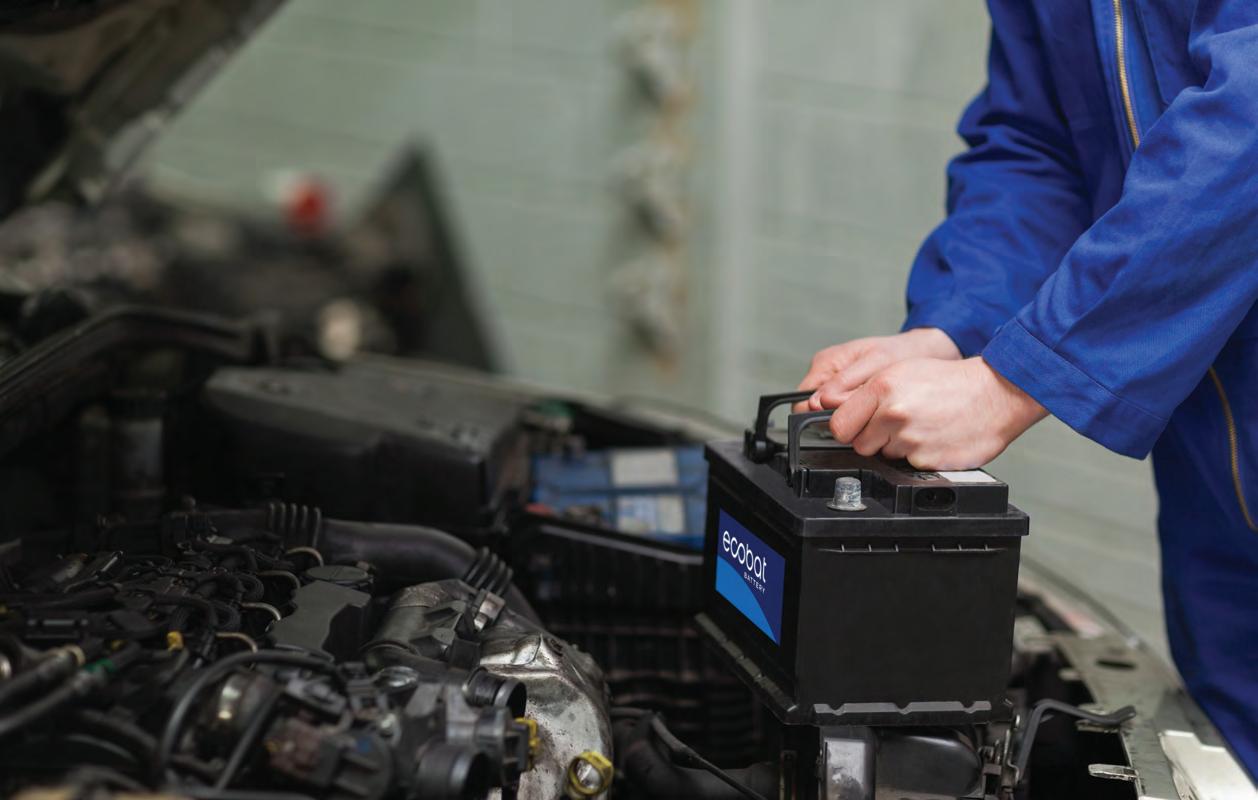
Whatever time of the year, batteries provide profit opportunities, argues Ecobat Battery, but it all starts with testing.

Incredibly, it’s now three years since the country started to emerge from its forced hibernation as the lockdown restrictions imposed during the worst of the Covid pandemic were eased and people started to venture out, only to find that their cars wouldn’t start as the battery was dead, discharged because of the vehicle’s lack of use over an extended period.
At the time, this provided the trade with a real shot in the arm as sales of replacement batteries soared, but now, a second opportunity is beginning to make its mark, as these very replacements are beginning to provide a ripple effect, as many of these are now coming towards their end of their lives. This development is likely to come into particular focus as the nights draw in and the temperatures drop, leaving many drivers to find their battery is faltering, or possibly completely flat.
However, a difficult question that’s been raised on many occasions, is that without drivers experiencing starting problems, how do they know where their car’s battery is in its lifecycle? The answer, which is a subject that has also been raised on many occasions, is to have the battery tested, but realistically, motorists are not going to do this proactively, so it’s down to workshops to put a battery testing regime into practice. This policy is even more important as the seasons change and the
increasing likelihood of some early morning frost or a prolonged cold snap.
Sadly, however, despite it taking just a couple of minutes, workshops rarely do a battery test, which is a wasted opportunity because as Ecobat Battery, the UK’s largest battery distributor, has found, statistically, 27 per cent of the vehicles that enter the independent workshop either need their batteries recharged or reconditioned, and a further 11 per cent need a replacement.
What all this means is that almost 40 per cent of the vehicles they service daily have a battery issue, so it is little wonder that 40 per cent of roadside breakdowns are due to battery failure, which is business lost to independents and gained by the national breakdown services.
“Even when disconnected, a typical lead acid SLI battery will discharge at the rate of 0.1 V per month, which means that a fully charged battery at 12.7 V will be discharged to the point that it would struggle to start an engine in just nine months.”
42 DECEMBER 2023 PMM BATTERIES & IGNITION
Workshop displays
So, to encourage and assist workshops to introduce a battery testing culture, Ecobat Battery can, through its motor factor customers, provide them with point-of-sale support material that includes battery testing report cards, counter displays, A4 leaflets and A2 posters, which are available in a choice of Lucas, Exide, VARTA or Numax branding.
As well as stating why they shouldn’t be overlooked by workshops, it’s worth exploring why batteries discharge, particularly in cold weather and ultimately, why they fail.
Even when disconnected, a typical lead acid SLI (starter/lights/ignition) battery will self-discharge at the rate of 0.1-volt per month, which means that a fully charged battery at 12.7-volts will be discharged to the point that it would struggle to start an engine (11.8-volts), in just nine months.
This natural discharge process is obviously exaggerated when the battery is connected because it is the only source of power to the

vehicles electrical system when the engine isn’t running, so its numerous electronic devices –clock, alarm, remote locking mechanism etc. – all constantly draw power, further increasing the rate at which it discharges.
Opening and closing the vehicle without driving anywhere puts more pressure on the battery as it can draw as much as 50-amps to do so; should there be a parasitic drain because of a problem somewhere in the vehicle’s electrical system, the issue is further exacerbated.
When these real-life scenarios are combined with cold weather however, the pressure on the battery moves to an entirely
new level because, even without these ongoing issues, when the temperature drops to freezing, the battery can lose up to 35 per cent of its power, which is why cold weather shows up battery problems so intently.
When it comes to why most batteries reach their end of life it is generally due to a process called sulphation, which is a chemical reaction that takes place in the electrolyte within the battery when the voltage drops to 12.4 or below, which causes lead sulphate crystals to build up on the lead battery plates. This reduces the battery’s capacity and cranking potential and signals the beginning of its demise.
These combined effects along with reduced car usage means that whatever the weather, the future remains bright for the replacement battery sector.

WANT TO KNOW MORE? FOR MORE INFORMATION WWW.RDR.LINK/ABD015

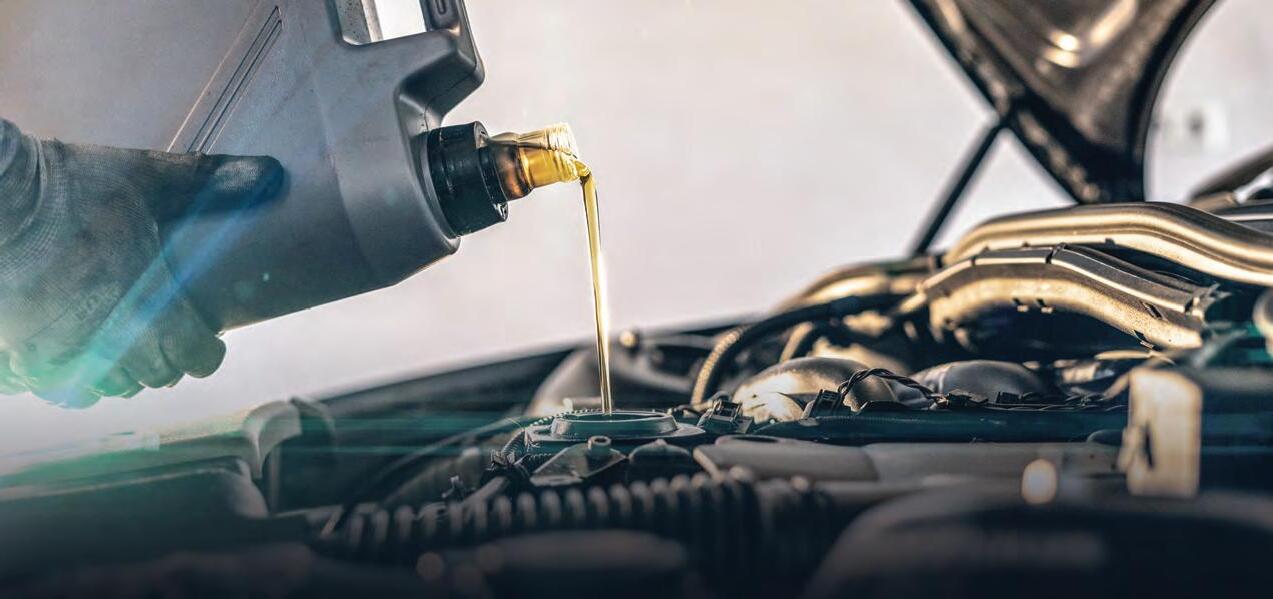
Why do we SERVICE cars?
Wynn’s discusses the importance of regular vehicle maintenance and provides some suggestions on how you can ensure customers’ cars work as efficiently as they can.
The most common operation in a garage is maintenance. Good maintenance work is essential to:
■ Extend the life of vehicles.
■ Avoid costly repairs due to wear and tear and contamination of parts such as EGR valves, particle filters, injectors, combustion chamber, turbo, etc.
Reasons for engine pollution
Vehicle pollution is unavoidable, although it is possible to extend the life of vehicles with maintenance work.
Fuel quality:
Today’s fuels do not come entirely from petroleum. Their formula is a blend of biofuels to make our vehicles more environmentally friendly. However, they also generate more waste and deposits that over time reduce performance and cause costly car breakdowns.
Anti-pollution systems:
The various anti-pollution regulations set by the EU have meant installing complex systems such as EGR valves, particulate filters, catalytic converters, and, more recently, the SCR system. Such systems reduce environmental pollution in exchange for retaining it inside the vehicles.
Driving styles:
Frequent city driving on short journeys, with engines that do not reach the correct temperatures, frequent accelerating and braking, and low engine speed driving accelerate internal pollution and engine wear.
The solutions to eliminate contamination
The maintenance recommended by car manufacturers – oil and filter changes – can, Wynn’s argues, lead to dissatisfaction on the part of drivers because the engine generally does not show better performance after maintenance. Even if the driver decides to check the oil level after the change, he would see that the sample would come out black, just like the old oil. With this in mind, the manufacturer argues that the use of additives during routine maintenance may reverse this view. Additives restore the original performance of vehicles and thus avoid costly repairs.


Wynn’s recommends using Wynn's Total Action Treatment Diesel for diesel engines and Wynn’s Total Action Treatment for petrol engines. Also, use an Oil System Cleaner to clean the internal enginebefore adding the new oil.
Potential benefits from engine additives:
Cleans the injectors Restoring the injector spray patterns allows better fuel delivery.
Cleans the combustion chamber
Removing deposits from the piston crown, increasing cylinder volume, and improving combustion efficiency. Reduces clogging of the EGR Cleaning the fuel system and restoring combustion efficiency reducing egr deposits.
Cleans the turbo Additives active after combustion, allowing cleaning of the turbo variable vanes and turbo wastegate.
Cleans the cat/DPF Additives active after combustion, cleaning the Catalytic Converter and Gasoline Particulate Filter and aiding regeneration of the Diesel Particulate Filter
Potential benefits from using an oil system
cleaner:
Remove deposits and lacquer from the oil system.
Restore cylinder compression restoring vehicle performance.
Allow the new oil to do the job it is designed to do.
Protect engine components and reduce wear.
PMM DECEMBER 2023 45
EXHAUSTS & EMISSIONS WANT TO KNOW MORE? FOR MORE INFORMATION
WWW.RDR.LINK/ABD016
ELECTRIC Dreams or DIESEL Demand?
Mike Schlup, managing director of Kalimex, UK distributor of JLM Lubricants, argues that the rumours of the death of the diesel engine have been greatly exaggerated.
The initial fanfare for electric vehicles has dampened with recent automotive surveys pointing to motorists not looking to switch to EVs for many reasons; not least range anxiety, the cost of EVs and the rising cost of living. In fact, motorists are not replacing their vehicles full stop. A recent survey by Cazoo found that 8 out of 10 motorists plan on keeping their car for longer. Added to this is the fact that second-hand ICE cars will be unaffected by the 2035 ban, and you can see why the second-hand market will remain buoyant with well-maintained vehicles in demand.
It points to the trusty workhorse – the hallmark of a diesel vehicle – being in big demand long after the 2035 deadline. Existing owners will want to keep theirs in good repair for longer while the second-hand searcher will be keen to grab a good diesel deal before stocks really do run dry.
What part does the independent technician play in all of this?
The independent professional motor mechanic plays a crucial part in maintaining the health of a diesel vehicle especially the DPF because we know from case studies of DPF specialists across the globe that the technician holds the keys. Motorists are only aware of the DPF on their vehicle when the warning light comes on.
But today’s technician has to keep repair bills reasonable given the reluctance for vehicle servicing. Take a blocked DPF for example.
Dismounting it for off car cleaning or replacement is time consuming which all adds to the final bill. But quality additives inject chemicals into the DPF directly, breaking down the soot without the need to expose the DPF to the potentially damaging high temperatures of a forced regeneration. Fewer technician hours, smaller bill, great result.
“Motorists are only aware of the DPF on their vehicle when the warning light comes on.”


JLM Lubricants supply a range of trade tested and trusted DPF products used in over 45 countries from the UK to Australia, the Netherlands and America. This includes a pro-only toolkit that will clean the most badly blocked DPF without dismantling it. Some products can be sold to the customer so they can play their part in keeping the DPF in good condition between workshop visits. It’s a win for everyone. The technician uses tools and products that reduce workshop time, and they build an additional revenue stream promoting best of breed DPF products to their customers.
JLM Lubricants DPF products for your workshop
Diesel Particulate Filter Cleaner
■ Contains a high percentage of active ingredients including Cerium and Platinum which works at lower temperatures. Cerium also has environmental benefits because it produces lower emissions than iron, including dangerous emissions (Cerium and Platinum help extend the life of the DPF core by helping carbon deposits in the DPF to burn off at a lower temperature around 400°C compared to iron-based formulas which artificially elevate the DPF temperature and produce more ash deposits.)
■ Cleans the soot filter and reduces air polluting particulate matter hydrocarbons, carbon monoxide and soot emissions.
■ Reduces soot and fine dust emissions by up to 25 per cent.
■ Significantly reduces likelihood of clogging and increases DPF service life.
■ Use at first DPF warning light.
EXHAUSTS & EMISSIONS
46 DECEMBER 2023 PMM
DPF Cleaning Toolkit
■ On vehicle systems for technicians only.
■ Cleans and restores very dirty/blocked DPFs without removal.
■ Use with the DPF Cleaning Fluid and the DPF Flush Fluid pack.
■ Saves time and increases the number of DPF cleans in a working day.
DPF Regen Plus
■ Ideal for servicing low mileage vehicles in between workshop visits.
■ Fuel additive designed to support the regeneration process of DPFs.
■ Regular use results in better DPF regeneration and a more complete oxidation of soot, improving DPF performance and reducing power loss.
■ Cerium base which is effective at a lower dosage than iron. When Cerium is burned, it produces less ash than iron which helps extend the life of the filter.

DPF Refill Fluid
■ Premium trade product, competitively priced.
■ Use as an alternative for all currently known manufacturers’ original parts numbers.
■ One bottle gives up to 70,000 miles protection.
■ Exchangeable fitments for different tanks.
■ Recent laboratory testing of DPF Refill Fluids proved that the JLM product contains the highest percentage of active ingredients. Cheaper fluids contained little or zero. Regular use of cheap products can cause thermal damage to the DPF core.
Thousands of technicians worldwide trust the JLM Lubricants’ DPF range of products for cleaning, maintenance, and servicing. They are in sync with the growing trend of repair over replace and products over parts. With an increased focus globally on the circular economy and sustainability, top tier additives such as these will deliver for the workshop, the motorist and the environment. WANT

TO KNOW MORE? FOR MORE INFORMATION
WWW.RDR.LINK/ABD017

Raisingyour EV game!
Maha offers advice on EV adaptors for two-post lifts.
As the automotive aftermarket takes strides toward electrification, the need for specialised equipment and tools to accommodate EVs is becoming increasingly urgent. As such, one important piece of equipment that requires adaptation for EVs is a two-post lift.
The rise of EVs has brought about a transition in workshop services. Unlike traditional internal combustion engine vehicles, EVs have specific components that demand unique considerations when it comes to servicing and repairs. An EV battery pack, for example, adds weight and safety concerns that need to be considered before conducting any work on the vehicle and component.
Two-post lifts and EV maintenance
Two-post lifts have long been a staple in workshops, offering technicians easy access to the underside of a vehicle for various tasks, from oil changes to suspension repairs; however, as the automotive landscape evolves, so must the tools involved.
Maha has long campaigned for the use of the correct adaptors on two-post lifts, citing
the wrong use of wood rather than the correct method of using either a 200mm sleeve or Ushaped adaptor, like an anti-slip sleeve, that fits either side of a chassis. EV adaptors are just as important; they bridge the gap between a lift’s arms and an EV’s unique frame, ensuring secure and safe lifting – reassuring for both technician and vehicle owner.
The equipment supplier offers a range of ATS manufacturer-specific EV lifting adaptors for the likes of Audi, BMW, Mercedes and Tesla.
Key considerations when choosing EV adaptors: Weight capacity: EVs tend to be heavier than their ICE counterparts due to the weight of the battery pack. When selecting which adaptor to use, therefore, it is important to choose one that can support the specific EV models technicians will be working on.

Safety features: Locking mechanisms prevent accidental lowering and secure the vehicle while it is raised.
Frame contact points: Adaptors should provide sufficient contact points with the EV’s frame to distribute weight evenly, thus, reducing the risk of damage to the vehicle during lifting.
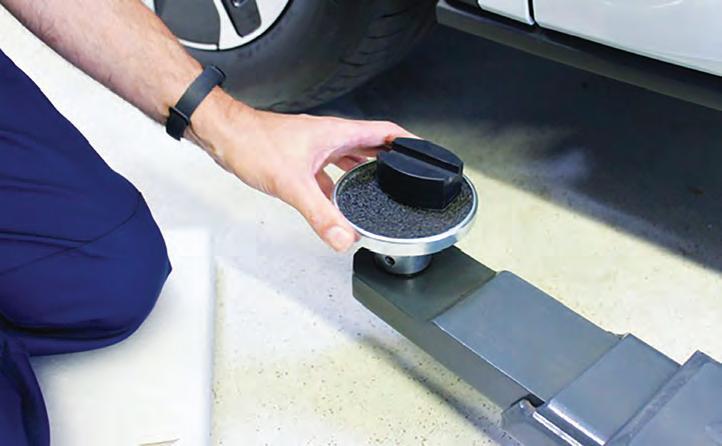
Adjustability: Some EVs have varying frame structures. Maha’s adaptors offer flexibility to accommodate different vehicle configurations.
Benefits of using EV adaptors: Safety: Adaptors designed for EVs ensure that the lift arms securely and safely engage with the vehicle’s frame, reducing the risk of accidents or damage during maintenance.
Efficiency: EV adaptors make it easier and faster for technicians to position and lift EVs, thus, improving overall efficiency in the workshop.
Versatility: While it is important to be wary of choosing the correct adaptor; in fact, many are designed to work with multiple EV applications, making them a versatile addition to a workshop’s toolbox.
PMM DECEMBER 2023 49
HYBRID & ELECTRIC VEHICLES WANT TO KNOW MORE? FOR MORE INFORMATION WWW.RDR.LINK/ABD018
EVHANDTOOLS:
TheTop5

1
Pliers set
While not a single tool, this set of pliers deserves a spot on our list due to its versatility and organization. The 00 20 01 V17 set includes a carefully selected assortment of pliers, all neatly arranged in a foam tray. This set typically includes combination pliers, diagonal cutters, and long-nose pliers, among others. Having a diverse set of pliers at your disposal ensures that you can tackle a wide range of tasks, from gripping and twisting to cutting and bending. The foam tray keeps your tools organised and easily accessible, saving you precious time searching for the right tool in the midst of a repair job.
2
The right tools can make all the difference between a smooth, efficient job and a frustrating, time-consuming ordeal. Whether mains charged, cordless or operated by hand, tools truly are the backbone of any car repair workshop. From tightening nuts and bolts to working with hoses, wiring, and other intricate components, the precision and reliability of these tools can significantly impact the quality of work performed by mechanics.
How to choose
So how do you choose the best tools for the job? When it comes to hand tools, picking the right tools comes down to many factors, but the main ones should be the quality of the manufacturing process and the specialisation of the tool, in other words, whether the tool designed for a specific job or purpose. Trying to use generic pliers for some jobs may result in frustration and loss of time, not to mention potential damage to the parts of a vehicle. In terms of quality, look for high-grade special tool steel, forged and oil-hardened for added strength and durability. Safety is also important – if you work with electric vehicles, then you will need to choose VDE rated tools.
Spring hose clamp pliers
Spring hose clamp (85 51 250 AF) pliers are an absolute necessity in any motor mechanic workshop. These specialised pliers are designed to securely grip and release spring-type hose clamps found in various automotive systems, such as coolant and fuel lines. This tool stands out due to its robust build quality and precision. Its long, slim jaws provide easy access to tight spaces, ensuring that hose clamps can be manipulated without damaging adjacent components. The unique locking mechanism of these pliers guarantees a secure hold on the clamp, preventing frustrating slippage during the removal or installation process.

Knipex takes a closer look at five essential hand tools that are ideal for the professional motor mechanic’s workshop.

3
Ear clamp pliers
One of the key features of ear clamp pliers is the ability to mount clamps without causing damage to the press points on the ear clamps. This is especially important for applications where the integrity of the clamp is crucial to the performance and safety of the system. The slim head of the pliers also permits good accessibility in confined areas, making it easy to work in tight spaces. The 10 98 I220 version weighs just 350g and has dimensions of 220 x 50 x 21 mm, while the 10 99 I220 version weighs 345g and has dimensions of 220 x 48 x 20 mm. Ideal for use on commercial vehicle boots, cooler and fuel lines, air pressure systems, compressors, and other applications where clamps are commonly used. With its durable and strong construction, the pliers are built to last and withstand the wear and tear of regular use. With the ability to work with Oetiker system or similar clamps, Ear Clamp Pliers provide a versatile and durable tool for a variety of uses.
HYBRID & ELECTRIC VEHICLES
50 DECEMBER 2023 PMM
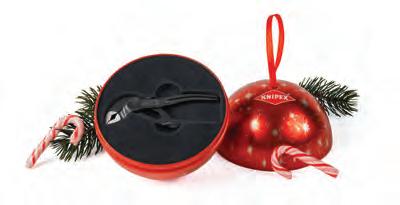
WIN!
Knipex is giving ten lucky readers the chance to win an XMAS Cobra XS tucked inside a festive ornament! The 100 mm water pump pliers feature 11 adjustment positions, 24 mm jaw capacity and one-handed quick adjustment. Its slim profile means it is suitable for use in tight spaces, while a pinch guard prevents operators’ fingers being injured.
4
TwinGrip
The TwinGrip is an ingenious tool for mechanics who frequently work with nuts, bolts, and other fasteners. This pliers-wrench hybrid offers the best of both worlds, combining the gripping power of pliers with the adjustability of a wrench. Its parallel jaws provide a secure grip on fasteners without causing damage, making it ideal for delicate or stubborn components. The push-button adjustment mechanism allows for quick and precise sizing, and the tool's slim design ensures easy access to confined spaces.
5
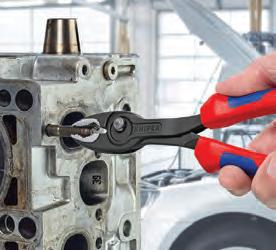
Long reach needle nose pliers
When it comes to reaching into tight spaces and manipulating small components, long reach needle nose pliers are indispensable. The 28 71 280 offers exceptional reach and precision, making it a go-to tool for tasks like wiring harness work, intricate hose routing, and adjusting hard-toreach parts. The slim, serrated jaws ensure a secure grip on even the tiniest objects, while the extended length provides access to areas that standard pliers cannot reach.
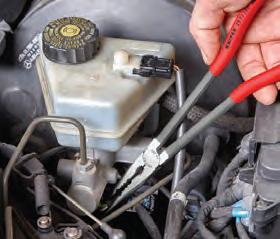
WANT TO KNOW MORE?
FOR MORE INFORMATION
WWW.RDR.LINK/ABD019
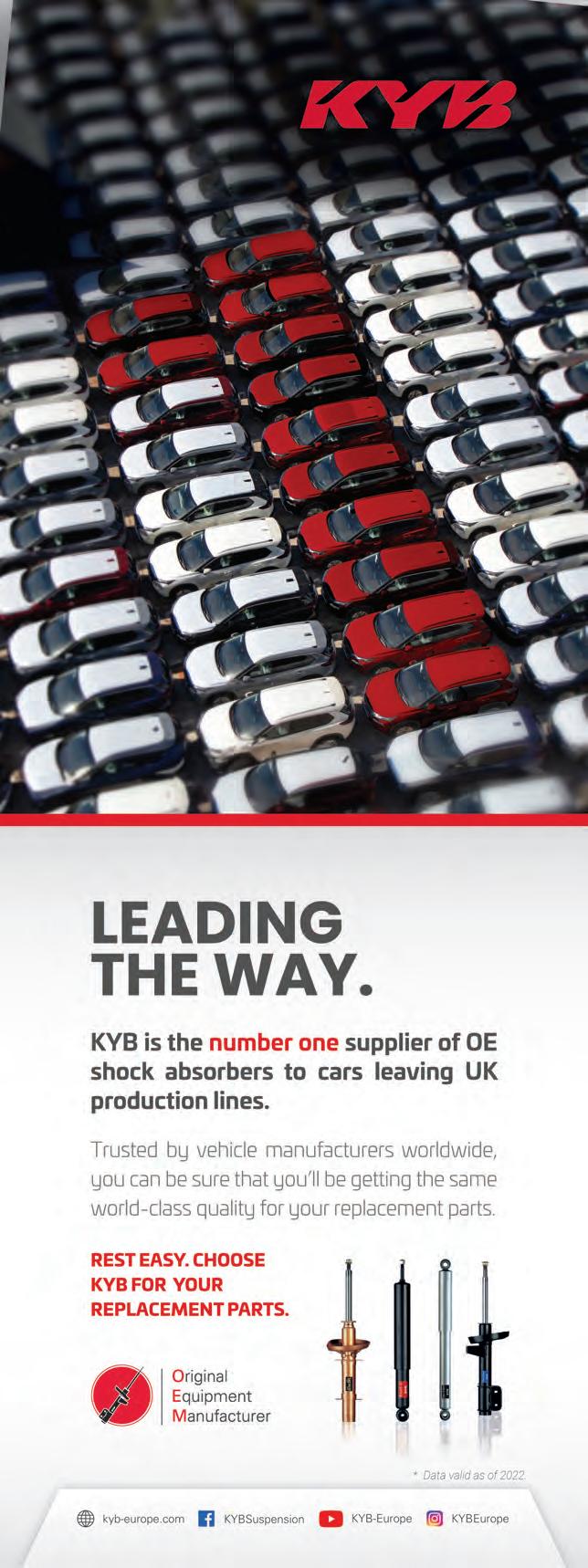
Handle EVs with confidence
in its EV training offering and has increased its focus on that complicated colossus of the battery-powered world: Tesla.



Delphi offers face-to-face training from its Titan 10 facility in Warwick. The focus is on future technology with vehicles, service equipment and test rigs available for technicians seeking ‘hands on’ experience.
Nearly three quarters of delegates attending the training courses are following a defined CPD training pathway, mapped to industry-recognised IMI qualifications.
Available paths include IMI service, fast- fit, service/diagnostic and master technician assessments. Each of the pathways provides between four and seven modules which are one or two days in duration. IMI accreditation is then dependent upon completing an additional assessment day afterwards.
The Delphi Academy gives a convenient way to enhance skills and knowledge without the challenges of attending physical training. There’s a training needs assessment which includes a series of questionnaires and online ‘practicals’ before suggesting modules to complete tailored to that user. Hybrid and electric vehicle training is the perfect example of the benefits of a true blended learning experience.
For the more advanced EV course we provide six hours of online pre-learning on
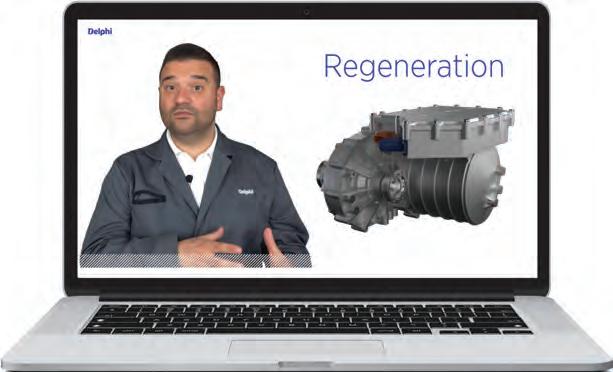
electrical systems to try and get the foundation knowledge of electrical principle to then build upon in the training centre. Delphi’s combined e-learning offering comprises 16 courses on vehicle electrics, hybrid and EV alone. In all, there’s a total of over 100 modules varying in length from a couple of minutes to nearly an hour each.
EV training growth
Four of the five most popular training courses relate to EVs and hybrids, perhaps not surprising given how registrations of electric vehicles are surging. According to SMMT figures, 2022 saw UK registrations of hybrid and EV cars exceeding the combined volume of petrol and diesel engine cars for the first time.
Delphi’s one day hybrid and electric vehicle level 3 course is designed to support technicians to work safely on high voltage systems, as well as petrol and diesel hybrid systems.
This would enable a technician to disable and power up the high voltage system safely to change components. All its EV training carries IMI TechSafe recognition too, demonstrating they are fully prepared to be working on EV.
Beyond this, there’s a two day level 4 course which covers diagnostics. With the power off, fault finding can be difficult so this course goes much more deeply into diagnosing live high voltage systems including high voltage battery repairs from different manufacturers.
HYBRID & ELECTRIC VEHICLES
52 DECEMBER 2023 PMM
Tesla suspension repairs



For those garages opting to get involved with EV repairs now, Tesla work can often form a surprisingly large part of the requirement.












Delphi has recently investigated a recurrent issue on the suspension system of the Tesla Model S. A Tesla technical service bulletin (TSB) relating to this fault (SB-1731-006) stated: ‘some Model S and Model X vehicles might have been manufactured with front suspension lower fore links that do not conform to Tesla’s subjective specifications for strength. In the event of link failure, the tyre might contact the wheel arch liner, but the driver can still maintain control of the vehicle.’


Earlier this year, to support aftermarket repair solutions, Delphi added a complete front suspension solution for the Tesla model S to the range, including all upper arms, lower arms, and anti-roll bar links.
Working with Tesla
Also in 2023, to coincide with the release of Tesla Model S and Model X coverage on Delphi’s BlueTech VCI diagnostic tool, an eleven-part course was added to the Delphi Training Academy. The course modules cover vehicle identification, data, and parts ordering as well as diagnostic hardware, connection, and common jobs.
“Everything is a little bit different when it comes to Tesla,” said Philip Mitchell, workshop solutions manager at Delphi. “But garages needn’t turn away these cars, they just need to understand how they’re different.”
Tesla’s browser-based diagnostic tool requires technicians to correctly configure a laptop or PC for vehicle connection. Further difficulties arise after successful connection
as Tesla’s distinctive IT-based jargon used within the tool can be problematic. The new e-learning course includes step-by-step video guidance, walking technicians through what can otherwise be a frustrating and time-consuming diagnostic process.
“The first stumbling block workshops face is knowing exactly which model they’ve got,” said Philip. “Knowing if it’s a Model S or Model X isn’t enough because they all use different processors and the method of vehicle connection will depend on which processor it has.
“And then you’ll have to get through a layer of Microsoft security if you want to use Tesla’s browser-based diagnostic tool. Unless you correctly configure your computer beforehand, all vehicle communication will be blocked and you won’t be able to connect to the car.”
An exam completes the Tesla module with a Delphi certificate and IMI continuing professional development credit for those achieving a 70 per cent pass mark or higher. As with all Delphi Academy modules, the Tesla content is presented in a user-friendly
format with multi-media learning methods including interactive technical articles, videos and simulators for all levels of ability.
Step-by-step Tesla repairs
Last but not least, Delphi’s ‘Masters of Motion’ hub – only launched at the start of this year – already provides ‘how to’ videos for specific Tesla repairs covering:
‘How to bed in the brakes on a Tesla ModelS’
WWW.RDR.LINK/ABD020
‘How to replace the upper arm on a Tesla Model S’
WWW.RDR.LINK/ABD021
‘How to replace the front lower arms on a Tesla Model S’
WWW.RDR.LINK/ABD022
WANT TO KNOW MORE? FOR MORE INFORMATION
WWW.RDR.LINK/ABD023

The RIGHT TOOLS totackleEVs
As the electric vehicle market experiences unprecedented growth, with pure electric cars seeing the biggest increase in new-car registrations in the UK during July 2023, accounting for 16 per cent of the market share, it has never been more important to invest in appropriate tools and training.
The latest statistics from the SMMT further support this, predicting that by the year's end, a new battery electric vehicle (BEV) will be registered every 50 seconds, and this rate is expected to increase to one in every 40 by 2024.
Changing landscape
The surge in EV popularity is a testament to the shifting landscape of the automotive industry. With concerns over climate change and the need to reduce greenhouse gas emissions, electric vehicles have emerged as a pivotal solution. Governments worldwide are introducing aggressive policies to encourage EV adoption, offering incentives and imposing stricter emission standards. As a result, consumers are increasingly turning to electric cars, and this trend is set to accelerate.
In this rapidly evolving EV landscape, the role of electric vehicle servicing tools and training cannot be underestimated. Here’s why they are crucial for both automotive professionals and the industry as a whole.
Tool specialist Sealey offers PMM readers its top tips on working efficiently and safely on electric vehicles.

SAFETY FIRST
Safety is paramount when working with high-voltage EV systems. Tools and training equip technicians with the expertise to handle electric vehicles safely as they learn how to identify potential hazards, follow strict safety protocols, and use specialized personal protective equipment (PPE) to minimise risks.
Sealey continually strive to develop new and innovative tools and equipment designed to keep technicians safe whilst servicing these vehicles. Products include high-voltage electrician’s gloves, an electrician’s safety mat, and a highvoltage rescue pole.

COMPLIANCE WITH REGULATIONS
As the EV market grows, governments are implementing regulations to ensure the safety and quality of servicing. Technicians who have received proper training and use approved tools are more likely to comply with these regulations, avoiding legal complications and safeguarding their reputation.
Any vehicle being worked on should be placed in an exclusion zone to create a secure working environment. The HP55K1COMBO is ideal for this purpose, as the post and chain kit and high voltage warning signs notify others of the potential danger, preventing them from entering the work area.
HYBRID & ELECTRIC VEHICLES 54 DECEMBER 2023 PMM
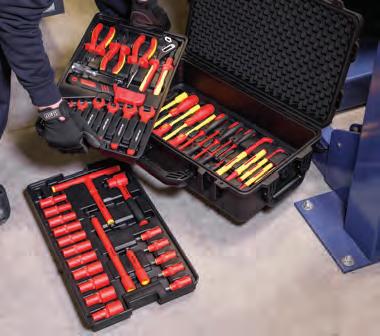
STAYING COMPETITIVE
The automotive industry is evolving rapidly, and those who adapt to new technologies are more likely to thrive. By investing in electric vehicle servicing tools and training, automotive professionals can position themselves as leaders in the market, attracting a growing customer base and staying competitive in the long run.
When working on hybrid or electric vehicle systems, a category III analyser or voltmeter is vital. The circuitry inside the unit is built specifically to safely cope with the high voltages and currents found in this type of vehicle. Sealey’s TA320 is category III and conforms to EN61010. For further protection from the risk of electric shock, VDE-approved tools must be used. The company supplies a wide range of tools insulated to VDE and EN 60900 standards, including the comprehensive AK7938 3/8 in. Sq drive and AK7939 ½ in. Sq drive tool kits.

Creating a better environment
Beyond the economic and safety benefits, servicing electric vehicles contributes to environmental sustainability. As more vehicles transition to electric power, proper maintenance and repair ensures that these vehicles remain on the road longer, reducing the need for new manufacturing and the overall impact.
The burgeoning electric vehicle market demands a proactive approach from automotive professionals. With electric cars becoming increasingly popular, investing in the right tools and training is essential for ensuring the safety and success of technicians and the industry as a whole. As the EVs increase, embracing these changes is not only responsible but also a strategic move for those in the automotive service sector.
WANT TO KNOW MORE? FOR MORE INFORMATION
WWW.RDR.LINK/ABD024




















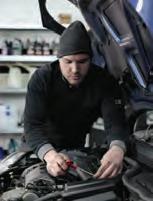



Every month, the PMM team works tirelessly to do our best to produce a magazine that is informative, instructive and entertaining for our readers. It is important to us that you remain as engaged as ever, whether that’s through our social media channels, our digital newsletter, tuning in to the podcast or even reaching out to us on the telephone or dropping us an email. We love hearing what you think about the magazine – what you liked and what you think we could improve.
Over the past year we have featured some fantastic articles, contributed from a huge range of excellent sources. Every

ACTRONICS
year, we round up the best ones and present the winners with that year’s PMM Award. As you can imagine, it’s no easy task! This year, we had a real struggle going through the articles we felt made the most impact and gained the most responses from our readers. We weighed up the most popular articles on the e-newsletter each week, the most requested rdr links, the most popular articles on our website and across our social media platforms – in short, compiling this list now encompasses a wider range of media than ever before. Because of this, we are confident it represents every aspect of the automotive aftermarket.


As good as new Kicking off this year’s awards is ACtronics with an article in which Thjs Jasink, the company’s COO, explains what goes into every remanufactured part. From diagnosing and removing the part, made harder by the complexities of modern vehicles, all the way through to the final inspection where the part has to pass an automated script and a visual quality control. The article also touches on how car manufacturers are increasingly encrypting components which makes it more difficult to replace them and why this might be an argument in favour of remanufacturing. With sustainability being a hot topic both in and out of the industry this year, it’s no wonder this article has made the list.
WWW.RDR.LINK/ABD 025










We would like to thank our readers who remain loyal and we hope you agree that this year’s PMM Awards represents the best selection of articles we’ve published yet. We would also like to thank the many companies who supported us both editorially and commercially over the past year. Your support is what enables us to put together the best magazine we can each month, something our readers will no doubt thank you for as well.
For now, let’s celebrate what makes this industry fantastic and raise a glass to the winners! Here, news and products editor Freya Coleman takes you through the past year.
BEN JOHNSON Troubleshooting issues
Those of you who diligently read through the magazine every month (and I’m sure that’s a lot of you!) will have observed that in every one of our 11 issues a year we run a feature called troubleshooter where a diagnostics expert gets to the bottom of a vehicle issue. One of the most popular of these articles in 2023 was written by Ben Johnson for the July/August issue.

Inside, follow along as he goes from watching a BMW X5 get dragged into his workshop on dollies after the appearance of multiple warning lights, to the diagnosis of a failed BDC and a change of battery that brought that car back to some semblance of normality.
With many common issues in cars being covered in our troubleshooter feature, including Ben and his work on BMWs, it’s clear to see the value of this feature and why it continues to be amongst the most popular with our online audience. After all, sharing diagnostics solutions IS caring.
WWW.RDR.LINK/ABD 026
FREE TOTHE ADE PMM NAL AN NOVEMBER ANEX SH IEW INSID OT EQUIPM NEED? ITH G TIN LE side R ICE& M N FREE TOTHE TRADE PMM Let’s get technical BEST PRACTICE ON CATALYTIC CONVERTERS THERMAL MANAGEMENT SYSTEMS INJECTORS, FORD FOCUS SUSPENSION & VAUXHALL CO O G OS IC TECHNOLOGIE EXPLAIN D D S DAVIES STS THE DURAGUNPRO ENTER THE CPD ZONE! YOU COULD EARN ONE CPD CREDIT THIS MONTH
AWARDS 2023 FREE TOTHE TRADE PMM IO A CHA JANUARY2023 WHY ARE OILS GETTING MORE COMPLICATED? Enter our giveaways! RAGE SOLUTIO FROM STR HT CEPT GAR EQUIPM PM GRO E M TRAIN LAUNCHED CH Let’s get technical A LA CH IGNIT G AR P AC FERE ADD COO RO UC AUN &RING FREE TOTHE TRADE PMM EV SERVICING THE POWER OF TONY POWELL’S DIAGNOSTICS TOP TIPS IS LIFE IN THE Let’s get technical INSTALLATION TIPS ON CLUTCHES & STABILISER LINKS THE CORE ISSUE: WHY REMANUFACTURING IS GOOD FOR THE AFTERMARKET PMM DECEMBER 2023 57


BOSCH
Making ‘ESI’ work of diagnostics


BREMBO
‘Braking’ point

If you’ve been reading PMM for a while you might remember when we first ran an in-depth guide to Bosch’s KTS diagnostics software, ESI[tronic] 2.0. With how fast technology is moving these days, we thought it would be a good idea to revisit the guide with Bosch and find out what has changed. The first instalment, which kicked off in the September issue, was all about finding the right vehicle which is key to accessing all the tabs you need to get your job done. Catch up on the ongoing series in each month’s issue.
WWW.RDR.LINK/ABD 027

CASTROL
‘Oil’ about EVs
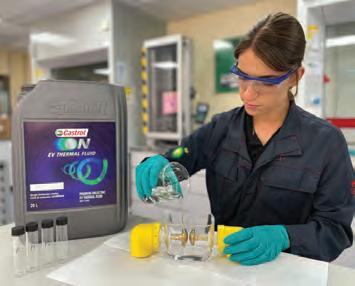
Another example of a company looking to the future, and more importantly looking at the sector’s electric future, is this next article from Castrol. Now, you might be thinking that as the UK shifts over to electric, with some predicting that 80 per cent of passenger cars on our roads could be EVs by 2050, oil might be left behind with ICE vehicles, but this isn’t the case. In fact, Castrol has been working closely with car makers and motorsport teams to develop its latest range of EV fluids.
The range currently consists of Castrol ON EV transmission fluids, thermal fluids, and greases. The ON EV transmission fluid's D1 and D2 variants suit a wide range of EVs, aiming to help extend the life of the drivetrain system and enabling EVs to go further on a single charge. This reflects the company’s aims to be a net zero brand by 2050 or sooner – an ambitious goal if ever there was one for an oils company.
WWW.RDR.LINK/ABD 029
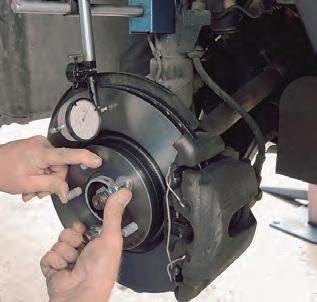
As you might expect, the PMM team is privy to a lot of rumours on the aftermarket grapevine during our travels, especially surrounding how the industry might change with the shift to EVs. One of these rumours was that EVs need to use brakes less than ICE vehicles. So, we turned to brake manufacturer Brembo which was there to set the record straight.
The company explains that even though EV brakes are used less due to the regenerative braking system, leaving braking actions up to the electric motor itself, this actually leaves them open to added corrosion. Other challenges outlined in the article mean that the brakes of electric vehicles need to meet the following requirements: corrosion resistent, silent operation, lightweight design and reduced residual torque. To combat these requirements, the Italian brake manufacturer has released the Brembo Beyond product line, the company’s replacement range tailored to improve EV driving.
With the future certainly looking to be electric, whether this is by 2035 or not, it’s great to see companies gearing up to help workshops in this somewhat turbulent transition.
WWW.RDR.LINK/ABD 028

DAYCO
Online traction
When articles are published on the PMM website, links are posted on our Facebook page which makes it a great place to stay on-top of the latest in the industry. It’s also a great place for Facebook members and/or PMM readers to discuss the content of the article. This definitely happened with this next article from Dayco which discusses some of the wider issues of the timing belt replacement on Ford’s 1.0 litre EcoBoost “Fox” engines. Commenters on our Facebook discussed their shared experiences and frustrations with issues faced in replacing the belt on Ford engines, proving the need for our online guides!

It’s great when our readers get involved online and we love to hear from you, and this is a great example of technicians engaging in the content we produce, hence why this article from Dayco has made the list of winners this year. Also, belt in oil Ford engine articles are very popular amongst our readers on the website, so we are grateful for Dayco for providing them!
WWW.RDR.LINK/ABD 030
58 DECEMBER 2023 PMM

DELPHI
One step at a time



Keen PMM readers will have noticed that halfway through the year our ‘Tech Tips’ feature transformed into the ‘CPD Zone’, standing for ‘continuing professional development’. This is because the magazine is now CPD accredited! One of the most popular CPD articles was from the June issue and written by Delphi who supplied a step-by-step EGR valve replacement guide courtesy of its Masters of Motion hub for independent garage technicians. Part of its success was down to the helpful images that accompanied the in-depth instructions.
So, next time you’re reading through the feature, make sure to scan the QR code at the end of the last article which will provide you with a downloadable certificate which can be used as part of your ongoing CPD record. With Delphi contributing regularly to the CPD zone this year, and the buzz it created amongst our readers, it’s clear to see why this technical article made the podium.
WWW.RDR.LINK/ABD 031


FEBI
Building the suspense...
Also part of our CPD Zone was this next article from febi, providing PMM readers with a guide on some common issues with the suspension system on the Ford Focus, a popular car amongst drivers but also one of the most popular vehicle models visiting workshops for repair work. So, it is well worth knowing the ins and outs of and it’s clear to see why this article was so popular amongst our online readers! Upon completing the article, readers will learn helpful tips such as how when the anti-roll bar links are worn, they can produce a rattling noise symptom while being driven on bumpy roads AND how to fix this.
WWW.RDR.LINK/ABD 032


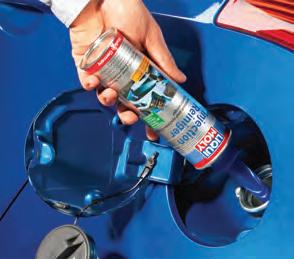

LIQUI MOLY
Read ‘oil’ about it
In this next article from Liqui Moly, head of application technology
Harry Hartkorn explains how the standard oil change service provided by garages could
actually be turned into a lucrative transaction. One example of how this can be done is through grouping services into packages, tailoring them to the vehicle and the budget of the customer. The example used here is the grouping together of cleaning the oil circuit, the actual oil change and extra wear protection. If this helpful advice wasn’t enough, the article then goes on to suggest the best Liqui Moly products to use with each of these steps, such as how the oil circuit can be cleaned with the Pro-Line Engine Flush.
At PMM, we often see a trend of very skilled technicians under selling themselves or missing out on business opportunities, so it’s great to be able to spread news of upselling opportunities from brands such as Liqui Moly. Furthermore, with the cost-of-living crisis still rearing its ugly head, tips on making more money in the workshop, whilst still helping your customer, are more useful than ever.
WWW.RDR.LINK/ABD 033


MOTUL
Modern oils for classic cars
Due to the popularity of Motul’s classic car article we ran back in 2022, we thought it would be a great idea to introduce a whole new classic car feature to the magazine. Sitting proud in this new feature is this next award winner Motul, sharing its insight on the classic car market. With this lubricant company being more than 150 years old, who better to shine a light on the increasing opportunities in the classic car market?
This article covers lubricants you can use on pre-war cars, all the way through to so called “youngtimers” which encompasses cars from the ‘80s, ‘90s and even the noughties and reflects the growth within the classic car market. Furthermore, with the UK car parc increasing in age and people holding onto the cars longer, we might see even more vehicles going from ‘banger’ to ‘classic’ territory.
WWW.RDR.LINK/ABD 035

LUCAS OIL
Take a pit stop
I don’t know about you, but with how hectic life can be I think it’s nice to take a breather every now and again which is the goal of our Pit Stop feature which sits each month sandwiched between articles on tech tips or business guidance. This page from the magazine which usually features a quiz and a joke or two written by yours truly, was given a makeover this year thanks to our next winner: Lucas Oil.

This revamp included a snippet of what life on the racetrack is like from Lucas Oil-sponsored driver Tony Lynch. Over this set of six articles, a real insight into the world of rallycross driving was revealed to us such as what happens when a broken fuel pipe occurs halfway through a heat or how to bounce back for a race on a Sunday when you went into a roll at 3pm on a Saturday. I’m sure you’ll agree, there’s some pretty thrilling stuff there and it’s so interesting to get an insight into the work behind the races.
Not surprisingly, there seems to be a lot of overlap between technicians and those interested in competitive driving, so it’s no wonder these set of articles have made the list of winners this year.
WWW.RDR.LINK/ABD 034


SOUTHEAST COAST AMBULANCE SERVICE
Vehicle repair on the front line
Prompted by a discussion at our Mechanex trade show last year with Ross Crook and John Giles, area workshop managers for the NHS’ Southeast Coast Ambulance Service, PMM’s editor Kieran Nee went to visit the service’s Make Ready Centre in Banstead. Now, you might imagine that your workshop has little in common with these centres that keep the NHS’ fleet up and running but Kieran expressed how it was interesting to find out that many of the pressures and challenges faced by the independent sector are also affecting the NHS. For example, does struggling to retain staff and failing to find parts sound familiar to you?
Did I mention yet that we have a podcast? You can listen to the interview in full in the episode aptly titled ‘NHS Visit’.
WWW.RDR.LINK/ABD 036
60 DECEMBER 2023 PMM

SCHAEFFLER
One in a million

Earlier this year, Schaeffler announced it had crowned its first Bonus Point Millionaire which came following a promotion run in the PMM magazine to celebrate its 10year anniversary. The winner, chosen from a random draw taken from the workshops who had purchased Schaeffler products between February and April, was revealed to be Markhams Garage which has an impressive 100 years of history. In this next article, therefore, PMM finds out all about the garage’s rich history including my personal favourite – the introduction of the MOT test in 1960. The test was originally only obligatory for vehicles over 10 years old and only covered a basic check on brakes, lights and steering. How times have changed!
WWW.RDR.LINK/ABD 037



SEALEY
The tools for success
When tools are rusted, dulled or are missing parts, completing the jobs you need to as a technician are made harder, longer and more dangerous. Therefore, to extend the lifespan of the tools you have invested in it is imperative to properly take care of them. In this next article, tool specialist Sealey gives its advice on maintaining and looking after the tools in your workshop. This includes buying proper storage for your tools and investing in rust removers and aerosols that help with corrosion protection. Making these investments can help save you money in the long run, which I’m sure is what all technicians want. Moreover, in a time of sustainability, it’s much better to invest and look after what your garage has, than to keep buying new tools.
WWW.RDR.LINK/ABD 038






STRAIGHTSET
An MOT makeover

The MOT has become a hotter topic than ever over the past year, with the government proposing a first test at four years and Garage Hive’s Alex Lindley revealing that there has been a 3.3 per cent FALL in MOT testers but 13.5 per cent RISE in MOT demand at The Blend. Therefore, the pressure on our MOT feature has been greater than ever but Straightset certainly delivered with its article from the April issue which provides readers with some advice on installing or upgrading their MOT equipment.
This includes choosing the right equipment such as an MOT lift, a jacking beam, a connected and approved brake tester, a headlight tester, an emissions analyser and an MOT accessory pack. Tips such as making sure your chosen emissions analyser is Euro 6 compliant and has MTS connectivity and the advantages of a combined gas and smoke analyser are packed inside this winning article, making sure your garage is carrying out MOT tests efficiently and safely.
Want to know even more about the state of MOTs in the UK and hear from other garages what they think? Make sure to listen to the ‘MOT Madness’ episode of the PMM Podcast.
WWW.RDR.LINK/ABD 039

TO CONCLUDE...
So, that’s it for the PMM Awards this year and I’m sure you’ll agree that this year’s list reflects the hard work both the team and our contributors put into the online and paper magazine.
If you want to see your favourite article on the 2024 list of winners, please reach out to me at fcoleman@hamerville.co.uk at any point throughout the year to tell me all about what your favourite article has been. Are you a fan of our technical articles, or do you prefer skipping to the back of the issue to read all about what new products are out? Either way, we’d love to hear from you. But remember, only the best articles can make the cut, so make sure your contribution counts!
Scan the QR codes below to keep up with the latest in the world of PMM, with our Newsletter, Instagram and Podcast.



AWARDS 2023

WOMANIC
Women in the workshop
Rounding off this year’s PMM Awards 2023 is the lovely woman behind Womanic: Louise Baker, an interview where we try to get to the bottom of why more women aren’t picking up a spanner and getting their hands dirty. This was originally conducted for the podcast which you can listen to now, but it was too good not to include some highlights in the magazine as well. My personal favourite surrounding her advice to anyone wanting to pursue a career in a workshop:
“My advice is to just do it. Don't think about it, just do it. Don't procrastinate, if you want to do it and you love it, and you enjoy it, no matter what it is, whether it's cars, whether it's anything, if you've got an interest in it, just do it. Don't let anyone tell you that you can't do it.”
And what a great message to end this year’s awards on!
WWW.RDR.LINK/ABD 040

62 DECEMBER 2023 PMM NewsletterInstagram Podcast
What’s new IN THE WORKSHOP?
with Freya Coleman
Dent puller kit
This dent puller kit from Gunson (part number 77175) allows technicians to fix minor, small or soft dents to a car’s bodywork. This is a glue-pulling dent repair system, where a pulling pad is hot-glued to the dent. It is then pulled out using the dent-pulling bridge. Included in the kit is a hot-glue gun: Rated at 40W and powered by a 240V mains supply. It's designed to melt the provided glue sticks, aiming to provide a strong and reliable bond. The dent pulling bridge then enables the glue pad to be slowly pulled up by turning the wing-nuts. This mechanism is said to allow you to slowly and precisely lift the dents, working like magic. Also included is a

plastic pencil punch, used to knock down any high spots, ensuring a smooth finish. The kit also includes two glue sticks and a bottle of glue release agent.
WWW.RDR.LINK/ABD042
Fog lamp harness connector kit
This assorted fog lamp harness connector kit from Connect Workshop Consumables (part number 87666) includes a set of 24 fog light connectors, each equipped with a

short harness. This is a comprehensive range of connectors, ensuring compatibility with different fog lamp types. Included connectors are as follows: H11 / H8 female fog lamp connector, H9 female fog lamp connector, Heavy-duty fog lamp connector, HB4 9006 fog lamp connector, 9006 fog lamp connector, 9005 fog lamp connector. Each connector is usefully supplied with 20cm of cable.
WANT TO KNOW MORE?
WWW.RDR.LINK/ABD043
RideorDieTool
Inspired by Louise speaking about her affinity for hammers, Liam, an avid reader of the magazine, wrote in to express what his ‘Ride or Die’ tool is!
“ ESPECIALLY DURING THE
BRUTAL WINTER
MONTHS
HERE IN THE UK, AND AS THE DAYS GET DARKER, MY FAVOURITE TOOL HAS TO BE MY HEAD TORCH. I LOVE BEING ABLE TO HAVE MY HANDS FREE TO WORK ON WHATEVER VEHICLE IS IN FRONT OF ME, AND BE ABLE TO SEE IT PAST 4PM IN THE WINTER! MY ANSWER MIGHT CHANGE WHEN THE SUN COMES OUT AGAIN. ”
Adjustable wrench set
This set of 3 wide-mouth adjustable wrench set from Laser Tools (part number 8676) features thin jaws and an extra-wide jaw capacity and is designed to make your work easier and more efficient. The set comes in three different sizes to cater to various tasks: the 165mm long wrench has a 32mm maximum jaw capacity; the 212mm wrench has a 42mm maximum jaw capacity and the 265mm wrench will open out to 55mm. Keeping your tools organized is crucial for an efficient workspace. The three wrenches come with a convenient hanging hole, allowing you to hang them on pegboards or hooks for quick access and tidy storage. Or keep them in their practical nylon tool roll organiser, so you can keep them together and always at hand.
WANT TO KNOW MORE?
WWW.RDR.LINK/ABD044

PMM DECEMBER 2023 63
KNOW MORE?
WANT TO
What’s new IN THE WORKSHOP?
with Freya Coleman
Green can be seen
Supertracker have updated the STR1 laser half cab and trolley to feature green lasers.
The use of green lasers is reported to improve the visibility, precision and clarity of the laser line. The human eye is inherently more sensitive to green light due to the photopic response, a phenomenon where the eye's peak sensitivity falls around 555 nanometers, which coincides with the wavelength of green light. This heightened sensitivity allows green lasers to appear brighter and more visible than red lasers to the human eye.

Go configure
Delphi has introduced an online configurator tool to its diagnostics portfolio which aims to offer an interface that helps workshops quickly and easily assemble a customised diagnostic package. It is designed to help workshops access market-leading diagnostic solutions so they can expand their service offering and repair quality.
The guided process aims to help the workshop to move through the options step-by-step which says to make it easy to compare different hardware, software, and accessories. It allows a user to start the configuration either by device type or by specific models or functions that are covered by the software, which are regularly growing thanks to continuous application

The STR1 Supertracker have now brought this enhancement to wheel alignment, offering laser wheel alignment systems with green lasers. The STR1 green laser wheel alignment system is available as a wall hung solution as a space saving option or on a trolley as a mobile solution. Both of which are designed in a neutral grey and black, which aim to complement the other equipment found in a workshop environment. This design update offers customers a sleek look, as well as brings together the company’s full alignment range into one uniform, straightforward design. Now supplied with a 9V battery, for increased battery life and supplied as standard with hangers to fit up to 24” wheels, with the ability to easily and accurate measure toe and thrust angle.
Green light advantages
Green lasers are visible in a much wider range of light conditions, meaning it should be effective for all year-round work, indoors and out as well as they can travel over longer distances. They also offer clarity and precision due to the brightness, all important factors in environments requiring pinpoint accuracy. This innovation led to an increase in popularity of green lasers in many applications such as construction, installation, surveying, medicine, entertainment, technology.
WANT
WWW.RDR.LINK/ABD045

development. This means that even if the technician is exploring the diagnostic offering for the first time they can still quickly and easily tailor the right options.
WWW.RDR.LINK/ABD046
64 DECEMBER 2023 PMM
WANT TO KNOW MORE?
TO KNOW MORE?
Product Spotlight: Snap-on’s SOLUS+ Scan Tool
Repair information at your fingertips
An upgrade
Snap-on has redesigned and upgraded its SOLUS platform. With exclusive SureTrack verified repair information and comprehensive coverage, it aims to provide all the sophisticated features that professional repair technicians need to handle a broad range of diagnostics without the complex functions that they don’t.
Features include...
SureTrack repair information delivers diagnostic experience and verified parts replacement records harvester from millions of successful repair orders. A onetouch code scan and clear that quickly performs checks and completes full vehicle clear codes for all available modules on the vehicle. Also, a custom data list that lets technicians customise the way they work, with freeze-frame, PID sorting, paise, zoom, PID trigger, snapshot and cursor functions
Tyre inflation
Autogem has inflated its tyre safety offering to the aftermarket, courtesy of an improved 6mm combination plug patch solution. The puncture repair product features upgrades to packaging which includes a QR code which links to a product training video. Two ‘cut-out and keep’ guides can also be detached from the box, which helps to identify where the correct safe and repairable tread area of a tyre is, as well

Work faster and more productively
With SOLUS+, get access to OEM-specific vehicles and work quickly as the boot up takes just two seconds and diagnostic results are available in as little as 30 seconds. Features include detailed trouble code definitions, live data, functional tests, relearns and adaptations. Instant vehicle ID automatically powers up and reads the vehicle ID when connected. Then, verify the diagnosis and repair with bidirectional controls for operations such as injector balance, gauge sweep, misfire detection, brake bleed and EVAP. Also, an embedded SMX operating system dedicated to diagnostic functions aims to provide fast, reliable operation.
WANT TO KNOW MORE?
WWW.RDR.LINK/ABD047

as tyre injury angle of penetration. A cube design allows for 40 patches to be stored in one box and prevents the patches from unnecessary exposure to the environment, inadvertent contamination or premature ageing. The combi-plug patches aim to enable technicians to perform tyre repairs that conform to British Standards.
WANT TO KNOW MORE?
WWW.RDR.LINK/ABD048

MESSAGE ME YOUR PRODUCT RELEASES OR YOUR FAVOURITE PRODUCTS AT FCOLEMAN@HAMERVILLE.CO.UK
Here is a useful summary of all the adverts that appear in this issue of Professional Motor Mechanic. Each is listed with its page number and a direct URL that will get you straight to the relevant online information
AC Tronics Ltd ..............................................................(page 27)
www.rdr.link/ABD100
Autodata ....................................................................(page 14,15) www.rdr.link/ABD101
AutoElectro ....................................................................(page 43) www.rdr.link/ABD102
Castrol (UK) Ltd ..............................................................(page 4) www.rdr.link/ABD103
Castrol (UK) Ltd ..........................................................(pages 6,7)
www.rdr.link/ABD104
Clarios (Varta) ................................................................(page 36) www.rdr.link/ABD105
ClickMechanic Ltd ........................................................(page 59) www.rdr.link/ABD106
Dayco Europe ................................................................(page 21)
www.rdr.link/ABD107
Ecobat Battery Tech ......................................................(page 34)
www.rdr.link/ABD108
Esprit ..............................................................................(page 61) www.rdr.link/ABD109
Ferdinand Bilstein UK Ltd ............................................(page 11)
www.rdr.link/ABD110
Granville Oil & Chemicals Ltd ......................................(page 31)
www.rdr.link/ABD111
Jack Sealey Ltd ..............................................................(page 17)
www.rdr.link/ABD112
JHM Butt & Co ..............................................................(page 53)
www.rdr.link/ABD113
Kalimex Ltd ....................................................................(page 39)
www.rdr.link/ABD114
Karnetic Ltd/Autel ..........................................................(page 56)
www.rdr.link/ABD115
KYB UK ........................................................................(page 51)
www.rdr.link/ABD116
Maverick Diagnostics ....................................................(page 34)
www.rdr.link/ABD117
Meyle ..............................................................(inside back cover)
www.rdr.link/ABD118
Motul ..............................................................................(page 47)
www.rdr.link/ABD119
Phillips Automotive Lighting/Lumileds ..........................(page 33)
www.rdr.link/ABD120
Pico Technology ............................................................(page 48)
www.rdr.link/ABD121
PMM Podcast ................................................................(page 23)
www.rdr.link/ABD122
Saxons ............................................................................(page 33)
www.rdr.link/ABD123
Schaeffler Automotive ..............................................(page 2/IFC)
www.rdr.link/ABD124
Snap on Equipment ........................................................(page 12)
www.rdr.link/ABD125
Snap on Equipment ........................................................(page 44)
www.rdr.link/ABD126
SP Diagnostics ................................................................(page 65)
w
www.rdr.link/ABD127
Topdon UK ....................................................................(page 55)
www.rdr.link/ABD128
Wynn Oil UK ........................................................(page 68/OBC)
www.rdr.link/ABD129
ADVERTISEMENT INDEX












































































































































































































































